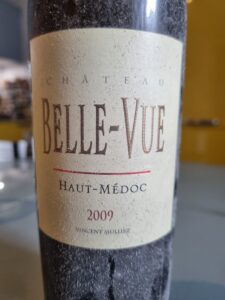
What in the world is a report on Argentinian wine doing on the Bordeaux wine blog? Well, it is not healthy for any wine lover to be totally focused on just one region. But also, as you read along, you will see that there are links between Bordeaux and the Argentinian wine country.
I had never been to Latin America until November 2023, so I was pretty excited about a trip to Argentina, a country five times the size of mainland France.
My wife and I arrived on the eve of the presidential elections there. Despite a massive campaign budget (funded, it seems, by the government in power…) the Peronist candidate, Sergio Massa, lost to the eccentric if not downright weird Javier Milei. It is hoped that Milei can turn the country around and put a stop to the 200% inflation rate. Although the heavily devalued peso wreaks havoc on the Argentinian people, it is a decided boon to tourists, who pay far less for things than in Europe or North America.
We spent a total of ten days in Buenos Aires and seven in Mendoza.
A few words about the capital before talking about Argentina’s wine country. The city proper of Buenos Aires has 3 million inhabitants, with 13 million in the urban area. As opposed to other South American cities, the population is largely of European origin (mainly Spanish and Italian) and the architecture there is also very reminiscent of Europe, with some tree-lined streets looking eerily Parisian. We went on several walking tours, including in the La Boca district, with its bright colours and unique charm. There is a monument on the Plaza San Martin to the 650 soldiers who died in the Falkland Islands war. I was worried that my wife, who is English, might run into some negative feelings because of the conflict, but most Argentinians seem to acknowledge that the war was an ill-conceived action taken by a military dictatorship seeking to make the country pay less attention to the disastrous situation at home.
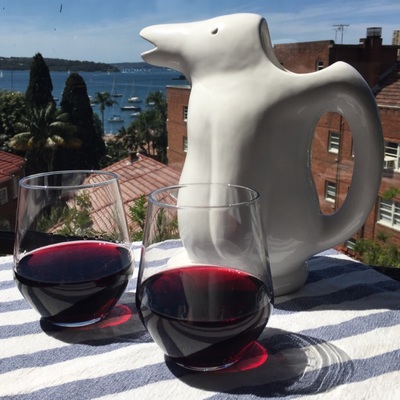
Food and wine: We found it possible to eat well in BA and everywhere else we went in Argentina. In 2023 you can enjoy a full meal for two with a good Malbec for the equivalent of 30 euros. We learned that it was often wise to split the main course because servings can be huge. Wine is reasonably priced and nearly always very young. There is a tradition of serving inexpensive wine in el pingüinito penguin-shaped ceramic pitchers in Buenos Aires. You can’t go wrong with these.
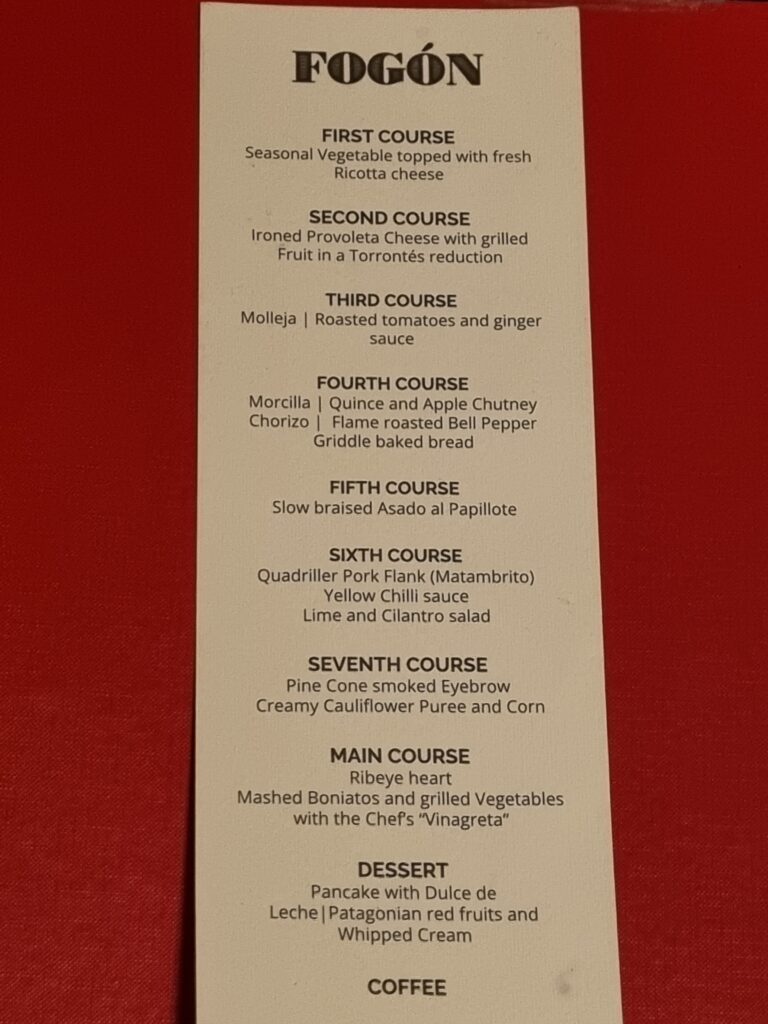
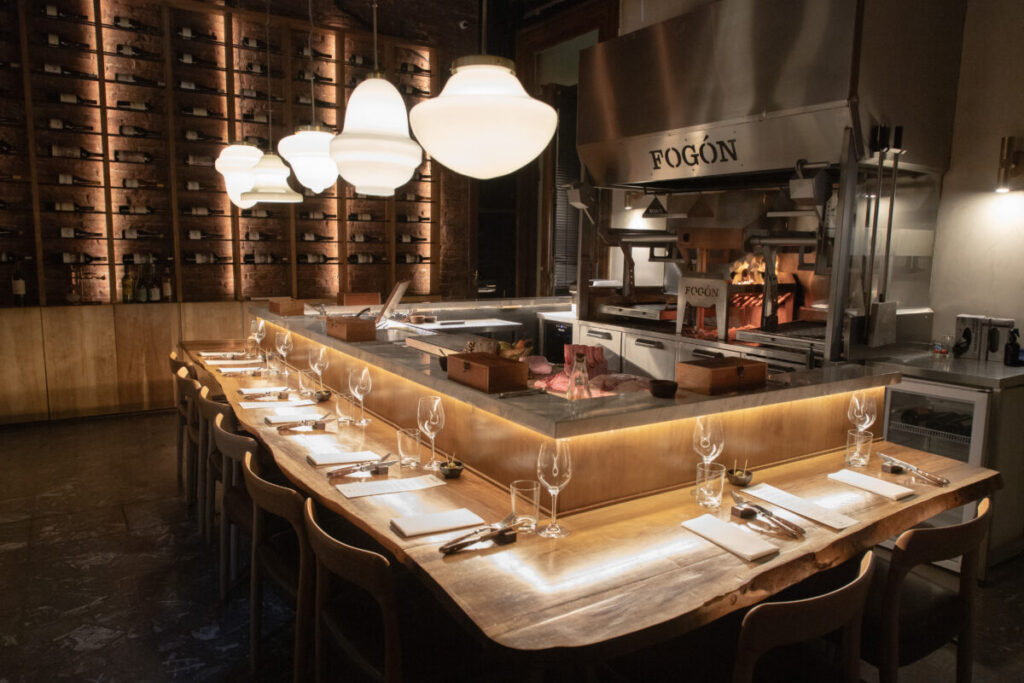
One address I would like to share is Fogón Asado on Gorriti 3780 in BA’s Palermo district. This provides the consummate Argentinian beef experience in an intimate setting. Ten of us (6 different nationalities), sat around a sort of bar surrounding a custom-made barbecue system in a small town house. The 9 course meal included various cuts of meat cooked to perfection, including types of wood adapted to each one! We opted for a Malbec wine to go with each course, including a sweet one with dessert.
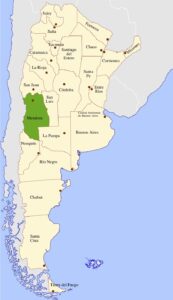
Argentina is the 5th largest wine producing country, and about roughly 70% of that comes from the province of Mendoza, over 1,000 km from Buenos Aires, not far from the Chilean border. My wife and I flew from BA to the city of Mendoza and stayed in the region for a week, spending 4 days visiting wineries. We hired a driver because we don’t speak Spanish and because there is zero tolerance for drinking and driving in Argentina. Therefore, even if we spat everything, I’m sure we would still be over the limit. As it turns out, our driver, Mauricio, spoke excellent English and was very well-acquainted with the wine industry.
There is a very go-ahead, can-do spirit in Mendoza and a pioneering approach reminiscent of California in the 1970s and 80s. Many of the cellars we visited were well-equipped, and with winemakers having extensive overseas experience. There were over 1,500 wineries in Argentina at the turn of the 21st century. For a variety of reasons, the industry, which goes back to the 16th century, declined and acquired a reputation for cheap wine of mediocre quality. This image has since been turned around, especially abroad (exports go primarily to the US, UK, Brazil, Canada, and the Netherlands).
The two largest companies are Bodegas Esmeralda (which owns the widely-exported Alamos brand) and Peñaflor (which owns Trapiche, also widely exported). Between the two of them, these firms are responsible for nearly 40% of total wine production in Argentina.
Several things set Argentina apart. For a start, most of the vines are ungrafted. Even though phylloxera is not uncommon, the most frequently-found strain causes little damage. Then, there is the country’s leading grape variety: Malbec. It is hard to know the exact percentage, but Malbec accounts for roughly half of all vines. Originally from France, where it is the primary variety in the Cahors appellation, Malbec thrives in Argentina because of the semi-arid climate, but with cool evenings. Many of the vines are irrigated with water that runs down from the Andes via conduits dating back centuries. Drip irrigation is common.

Located at the foot of the mountains, Mendoza is a city of about 120,000 people built on a grid pattern. A terrible earthquake in 1861 killed thousands and destroyed most of the historic buildings. The guide books tend to downplay Mendoza, but my wife and I found it an enjoyable place to stay. It is the center of a burgeoning wine tourism industry.
We visited thirteen wineries in four days and tried many other wines at restaurant meals.
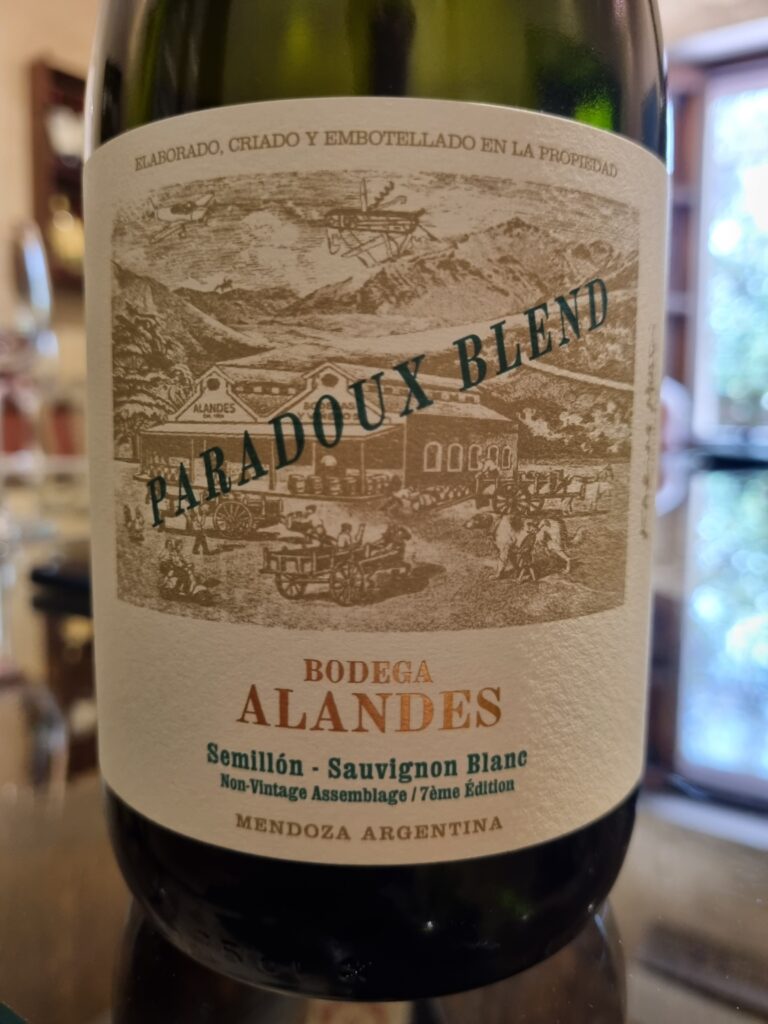
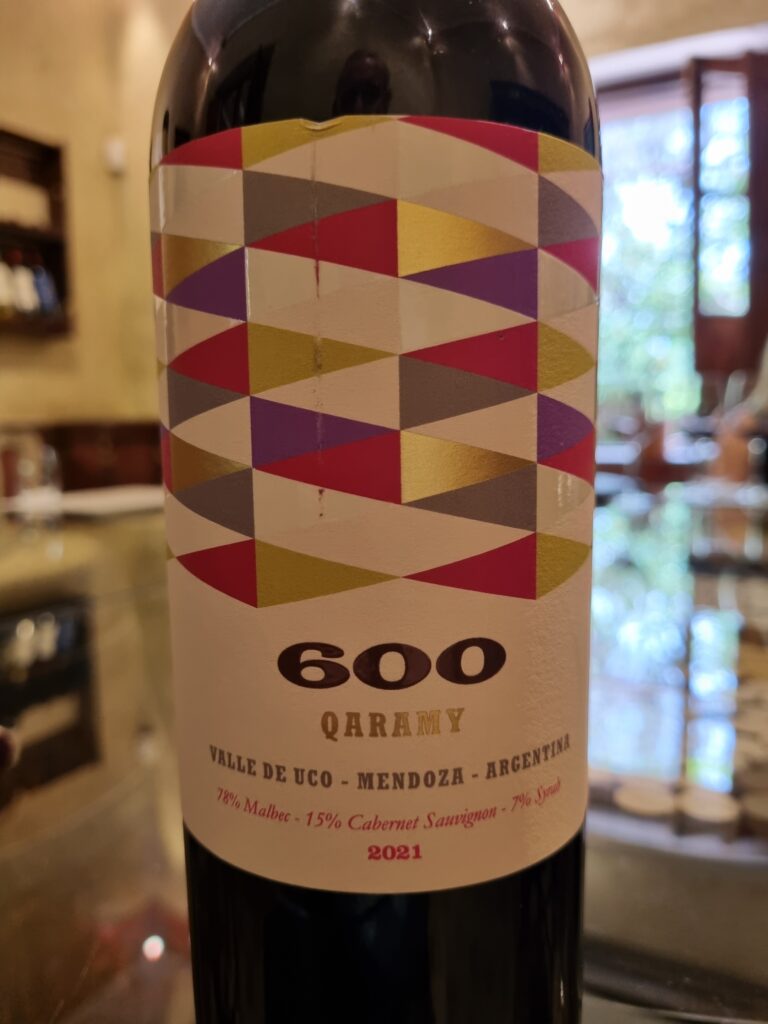
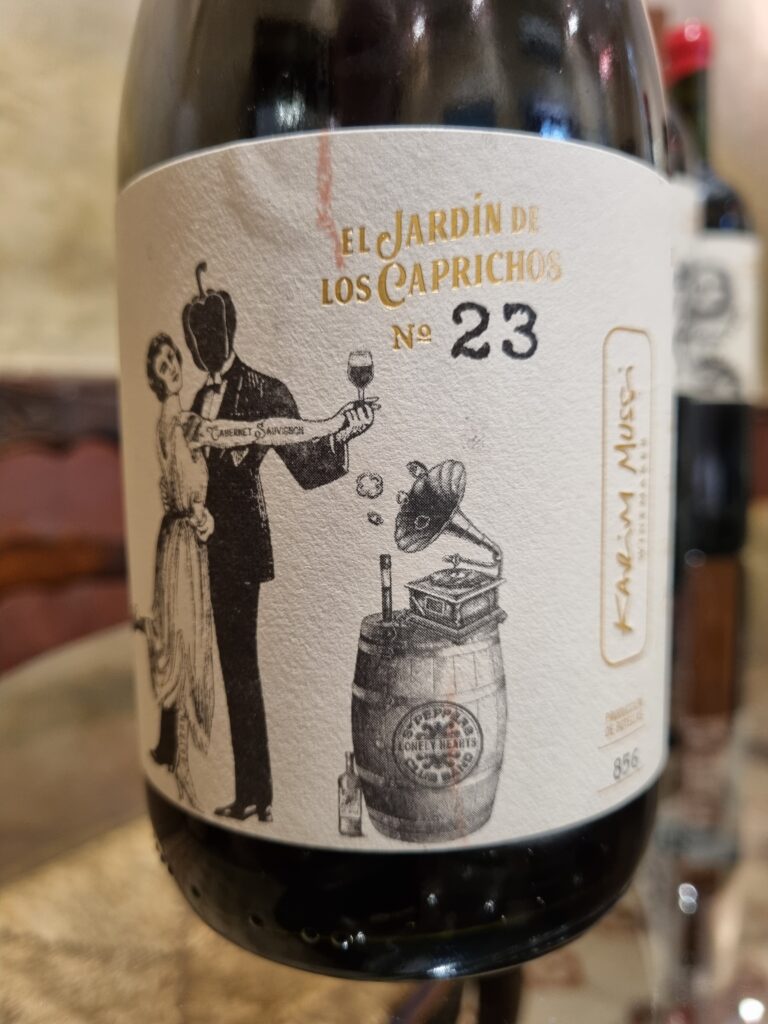
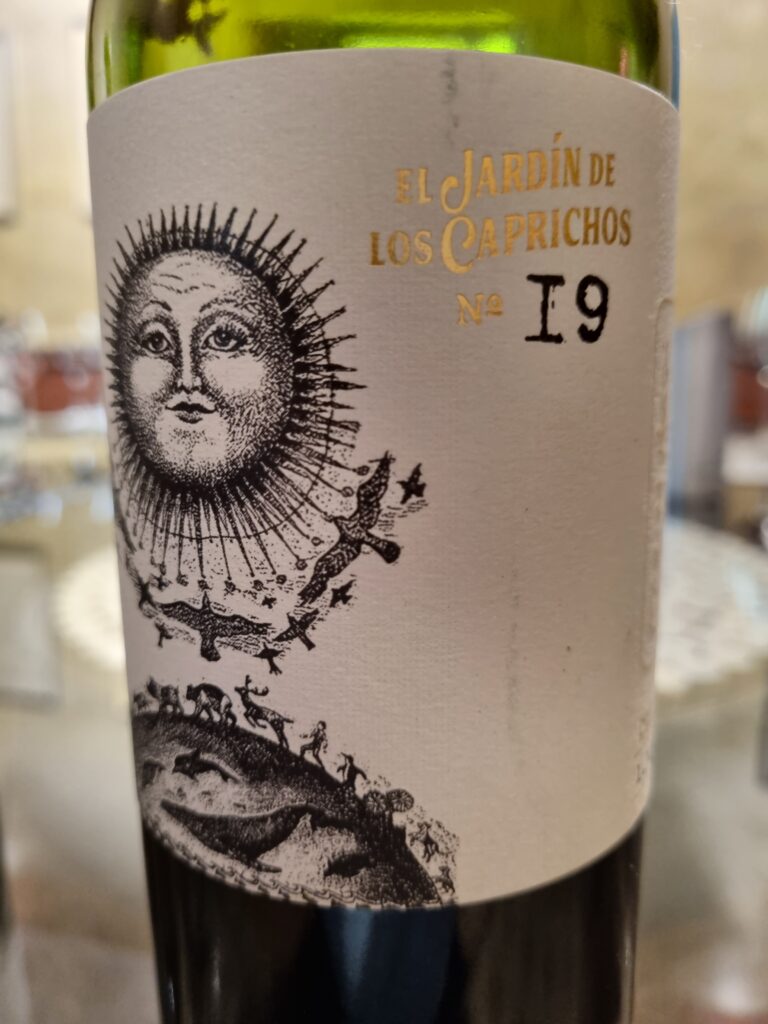
Our first visit was to Bodega Alandes in Maipú. The tasting room is located in a historic mud brick building although the small cellars there are mainly for show. The main facilities are elsewhere. The winery buys grapes from various regions rather than growing them. Also in the New World mold, winemaker Karim Mussi, whom we did not meet, maintains a high media profile, reflecting the star system approach to marketing. He has also presided over Altocedro since 1999 and Alandes since 2012.
We started out with a 2022 Torrentés. We were to encounter this variety again and again in Argentina. Unfortunately, I never really took to it. Most times it is semi-sweet, but this one at Alandes was very tart and not really to my liking. Another white, the Sauvignon Blanc/Sémillon Paradoux was much better, if a little too oaky for me, The red wines were quite good. The 600 Qaramy 2021 from the Uco Valley – a Malbec, Cabernet Sauvignon, and Syrah blend – showed berry fruit aromatics, good structure, and a promising future. Quite a successful wine. The 2011 Jardin de Los Caprichos No. 19 Malbec, one of the few older wines we tried in Argentina was a touch rustic, but packed with flavor. It reminded me a bit of a Rioja, with a dry finish. The Jardin de Los Caprichos 23 was big, strong, and Zinlike, with 15% alcohol.
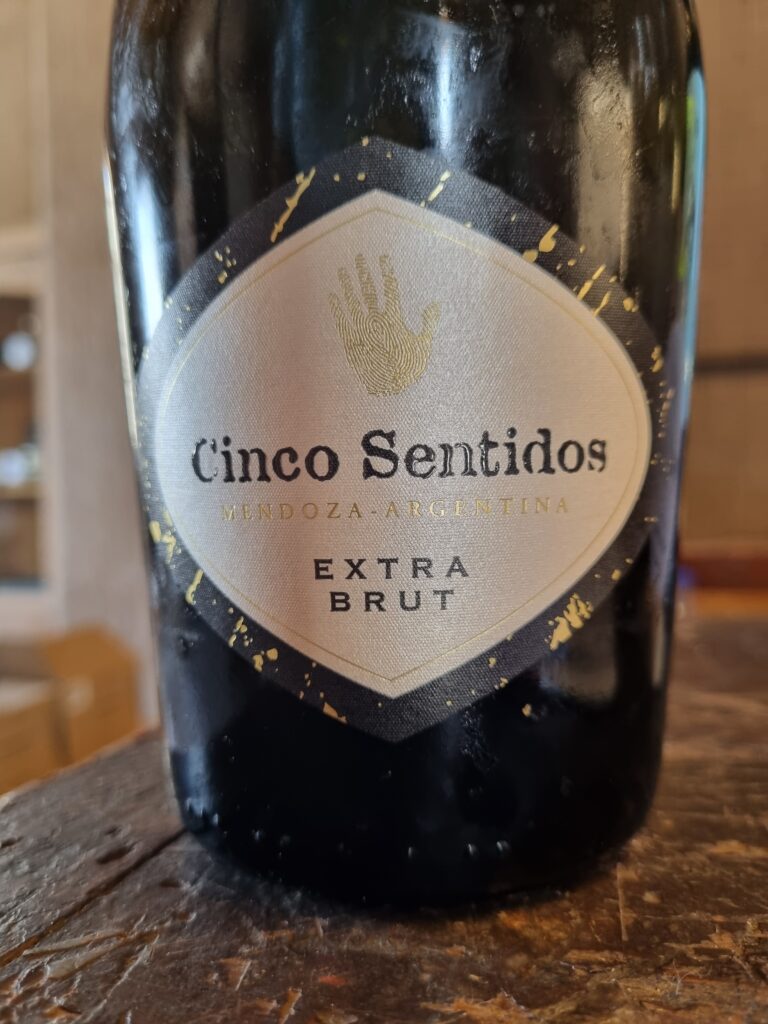
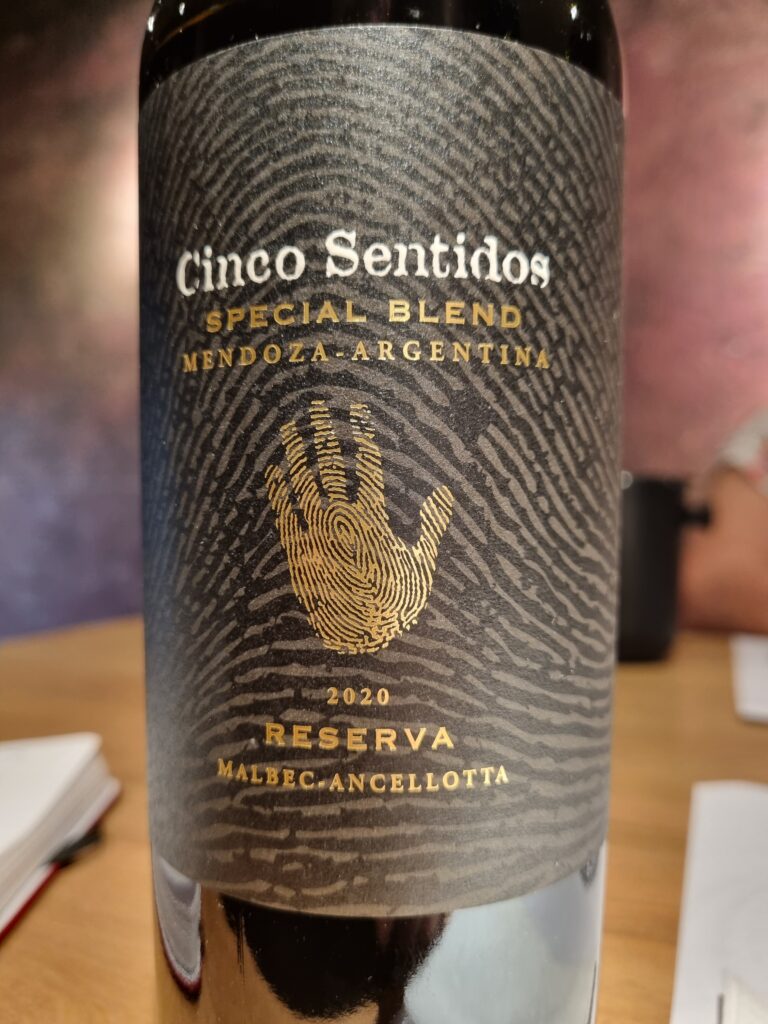
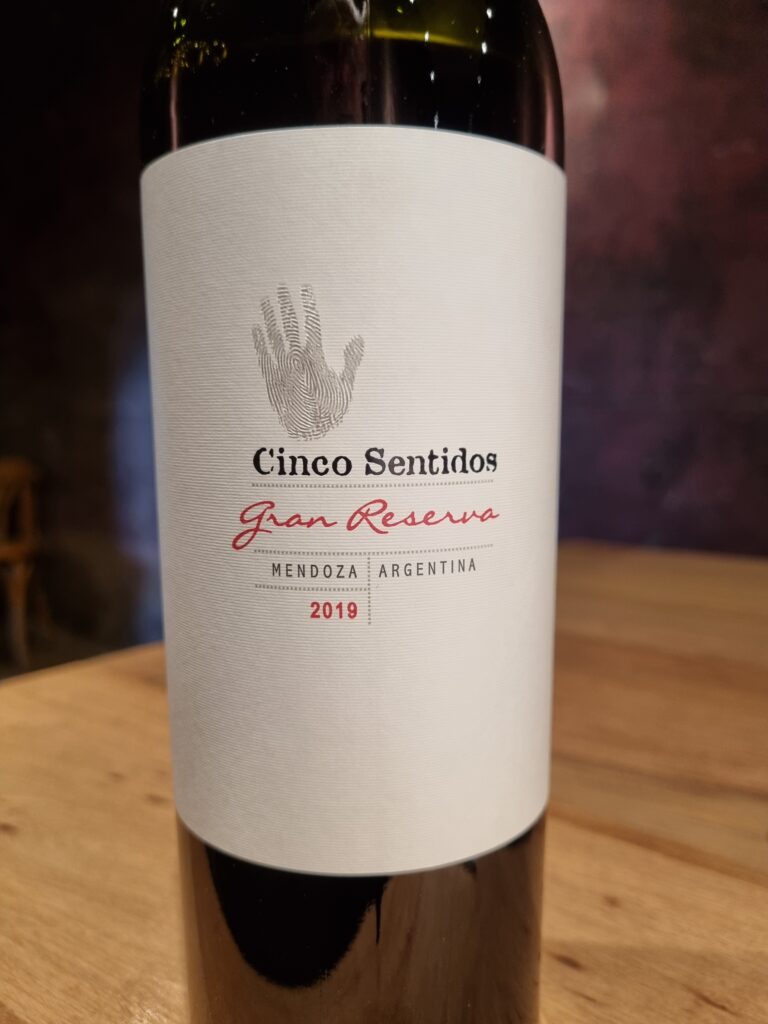
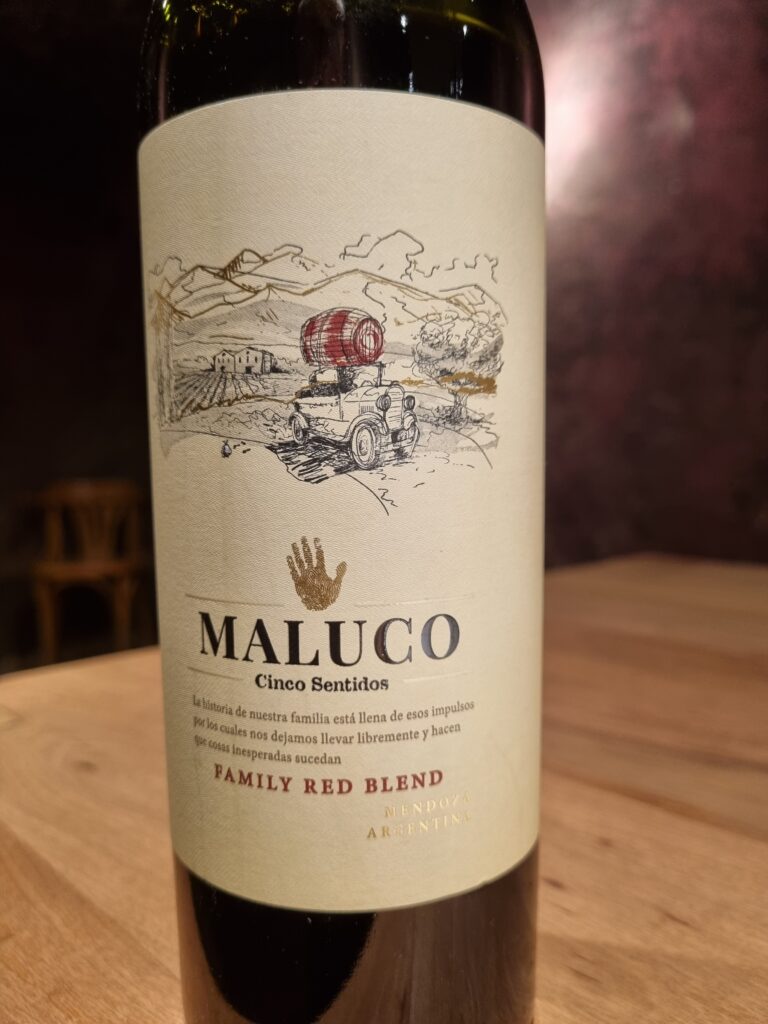
Family-owned Cinco Sentidos (Five Senses) is an attractive modern winery incorporating the original utilitarian building. They have 100 hectares of vines on the banks of the Mendoza River. We tasted through their range in a room that was once a huge vat. The sparkling Torrentés was unremarkable. The 2020 Malbec Reserva was fresh with cedar and peppery notes. It was big, smooth, and crowd-pleasing, but short on the palate. The 2019 Gran Reserva is a blend of Malbec and the two Cabernets. It was rich and round with soft silky tannin. Although once again a tad short and a touch hot, it was nevertheless a very worthwhile wine. The 2021 Maluco was very New World in style, with eucalyptus on the nose. It was a little too hard and dry for me. “Maluco” means crazy in Portuguese, a language referring to the owners’ roots.
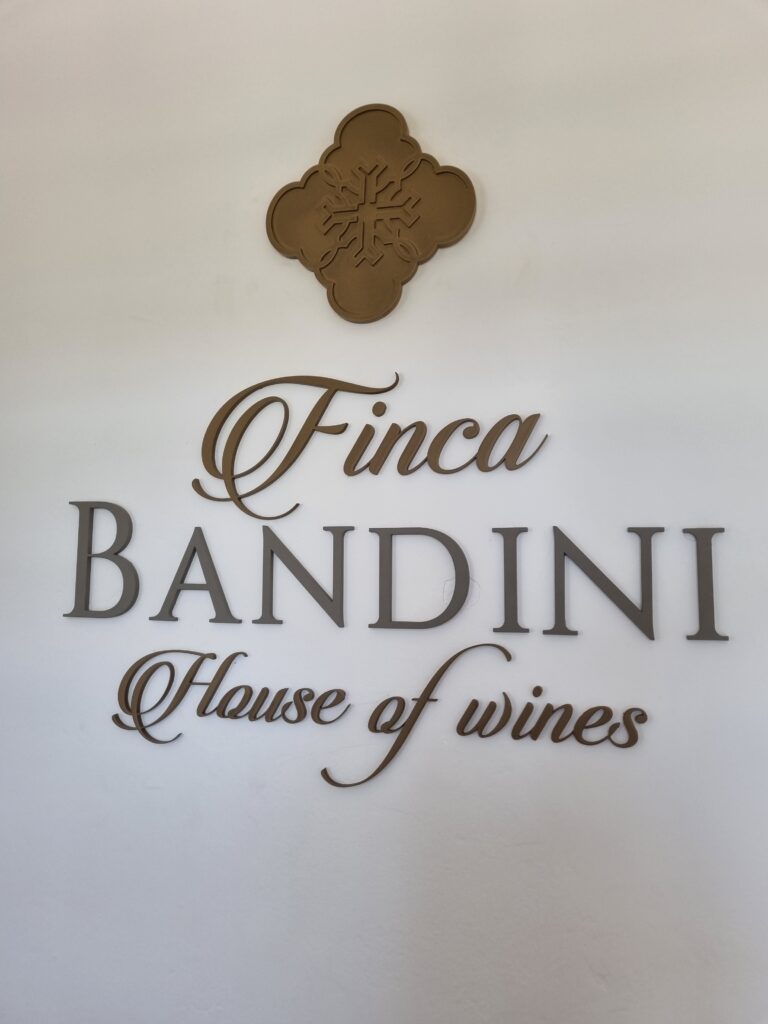
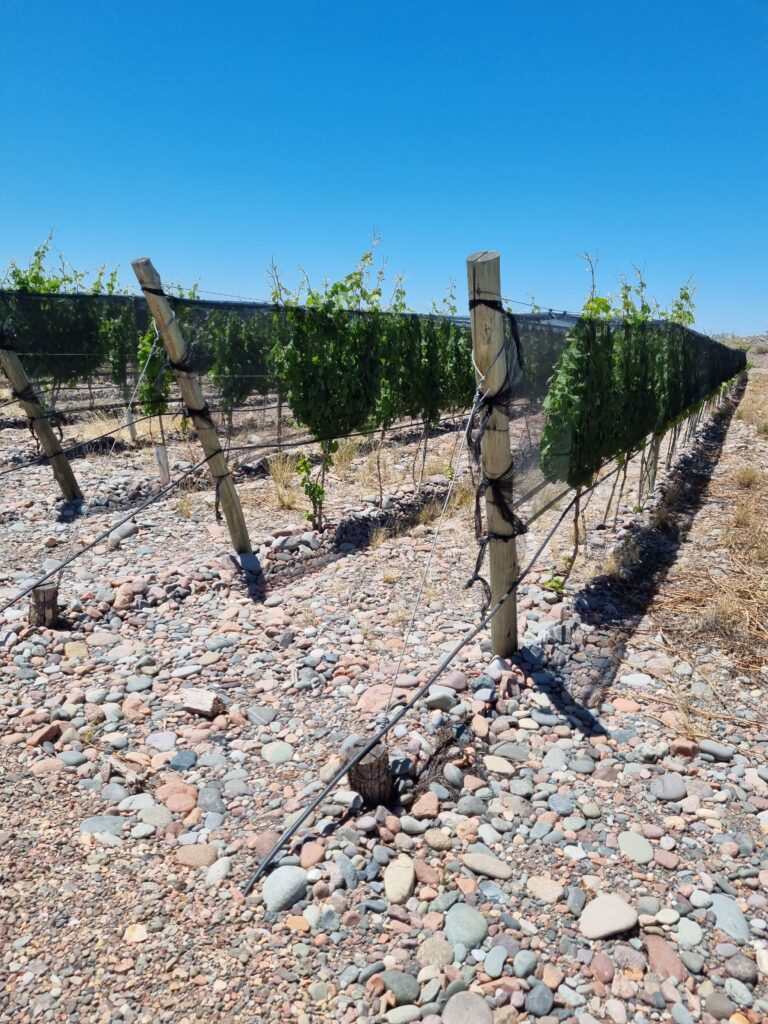
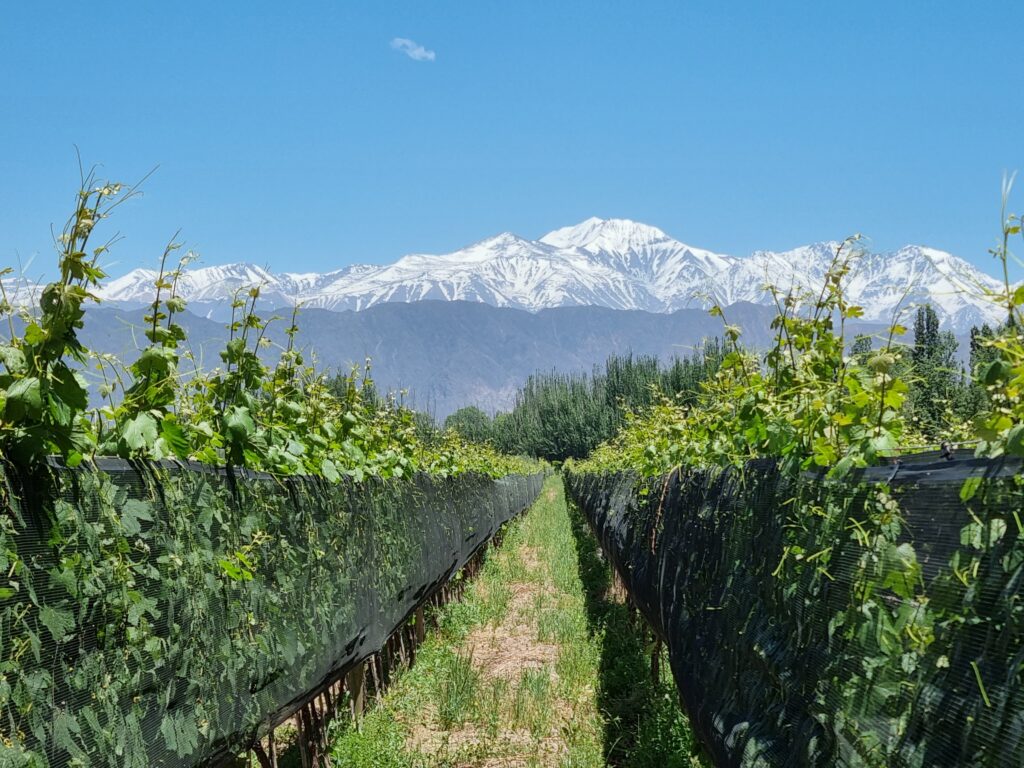
Bandini : Finca Bandini very much corresponds to the European conception of a wine estate. It is in a a beautiful oasis bordered by the Mendoza river, which irrigates 60 hectares of vines in a single block. The soil is full of rocks washed down from the Andes, whose snow-capped peaks provide a dramatic backdrop. We met Federico Bandini, a native son who moved to Houston, where he made a fortune in the oil business. He jumped at the chance to buy this amazing site in his home town, Lujan de Cuyo and entirely reinvented it, planting vines as well as building a new winery and visitor center. Everything is geared up for wine tourism (visitors are taken around in a golf cart).
We tasted through seven Bandini wines.
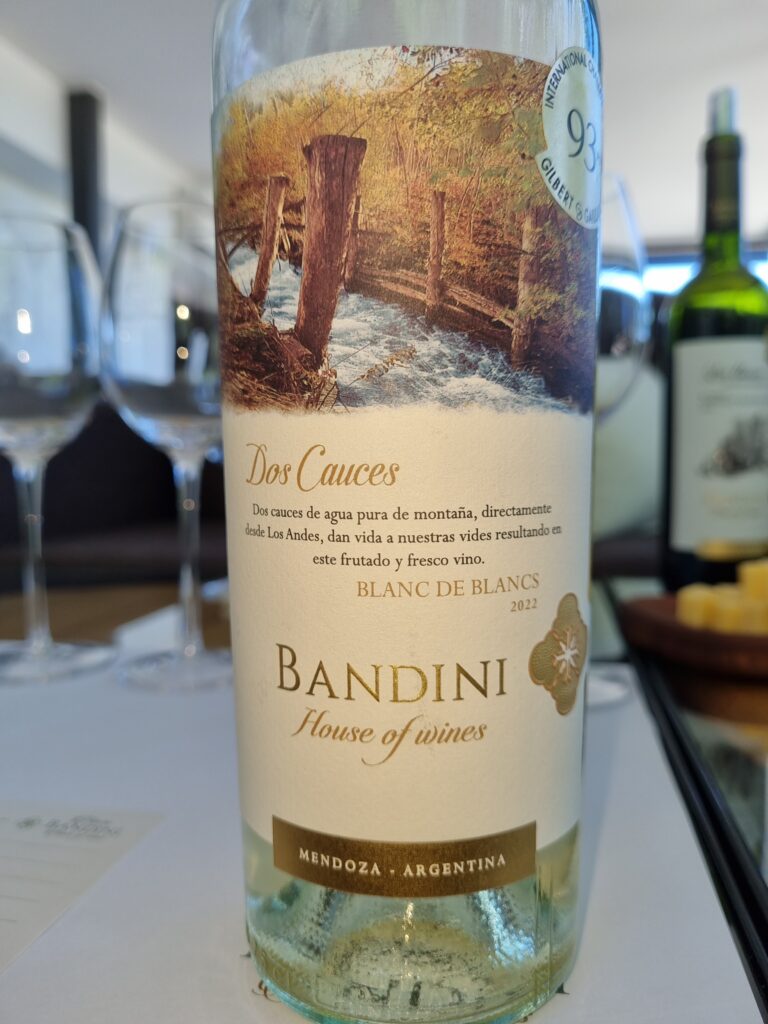
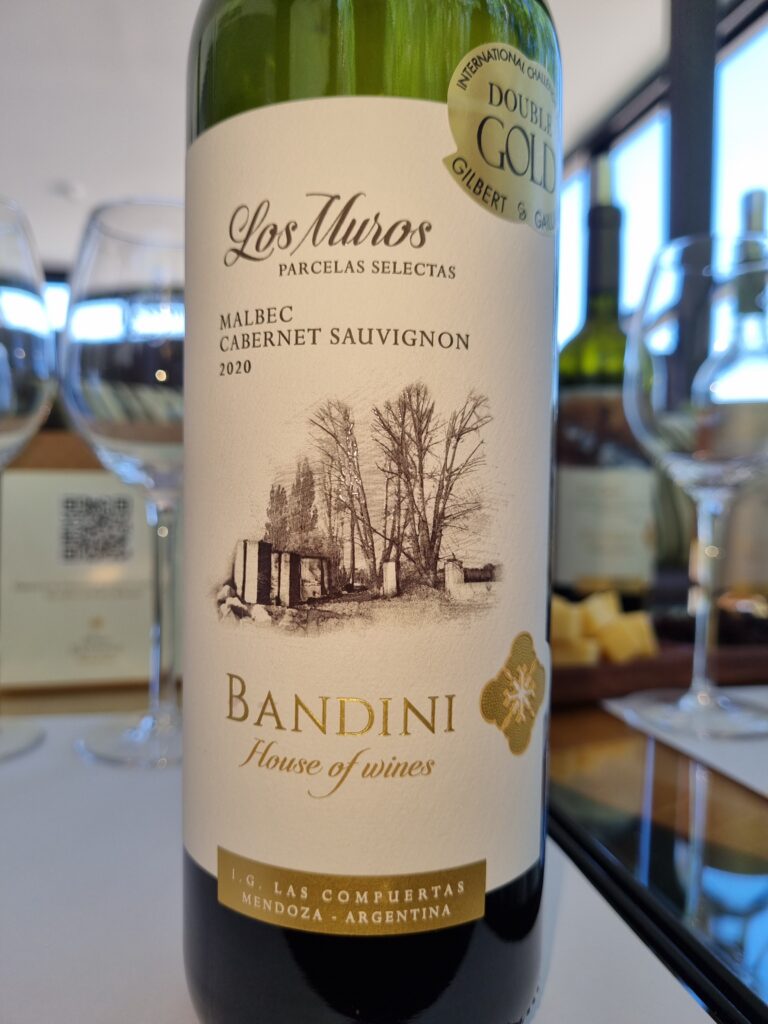
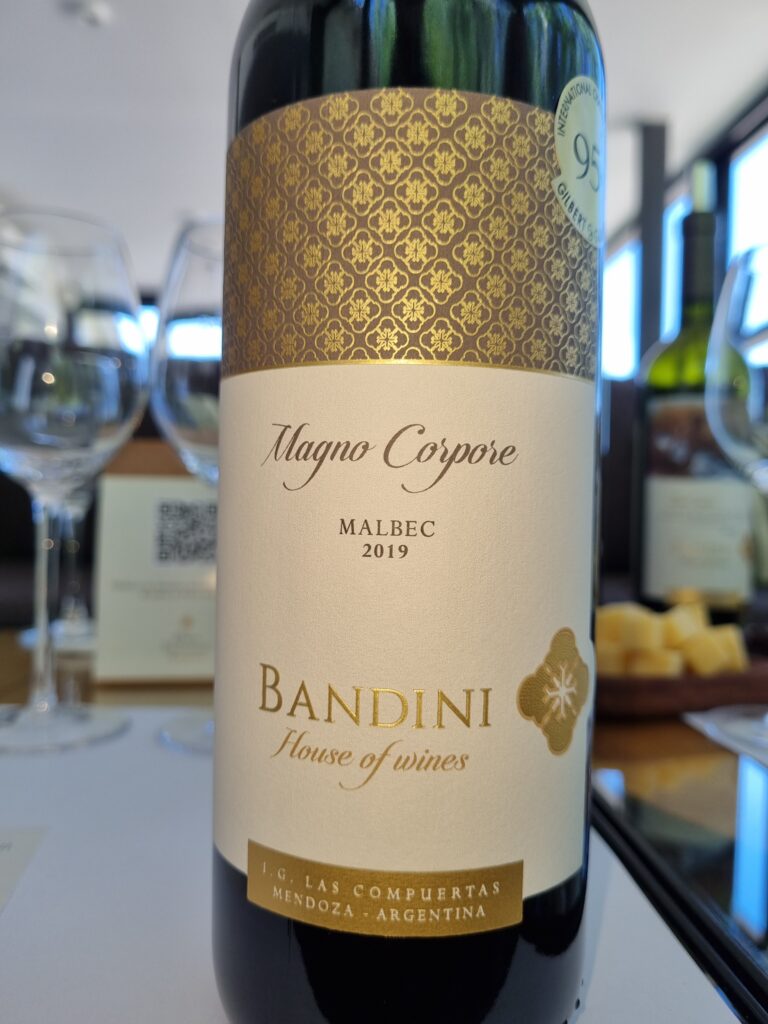
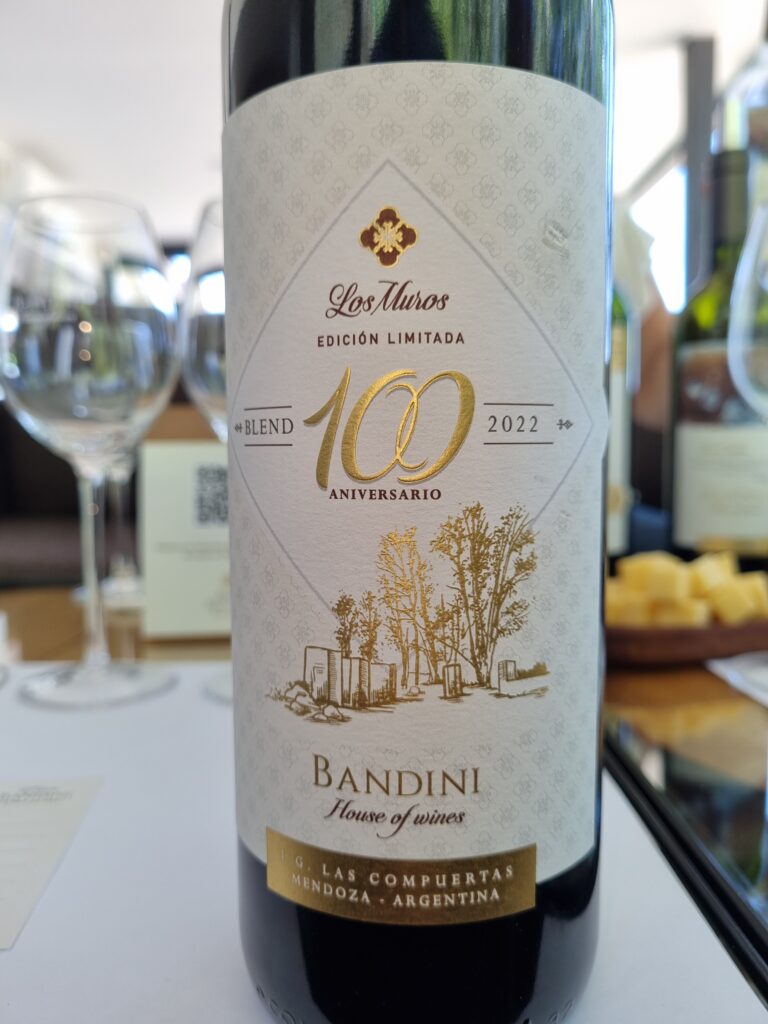
The 2022 Dos Cauces (Two Streams) is made from Uco Valley grapes. This is a blend of 50% Chardonnay, 40% Viognier, and 10% Sauvignon Blanc. This proved to be simple, with good acidity. After a Gewurtztraminer and Malbec Rosé, we sampled the 2019 Dos Cauces Malbec, from Mendoza. This was very forthcoming and with a gentle tannic bite. Elegant and very seductive. The 2020 Los Muros (The Walls), an estate wine, consists of 87% Malbec and 13% Cabernet Sauvignon. It showed dark fruit on the somewhat subdued nose. The wine was spicy and interesting on the palate, with good acidity. We went on to the 2019 Magna Corpore Malbec. The nose was a bit off at the time and the wine clearly needs time to come together, so judgement is reserved. The last wine was the 2022 Limited Edition 100th anniversary wine, a 100% Malbec from Lujan de Cuyo. The bouquet was redolent of green and black pepper and the wine obviously has considerable ageing potential. It is fermented and aged in new French oak barrels, whereas the other reds are kept in egg-shaped cement vats.
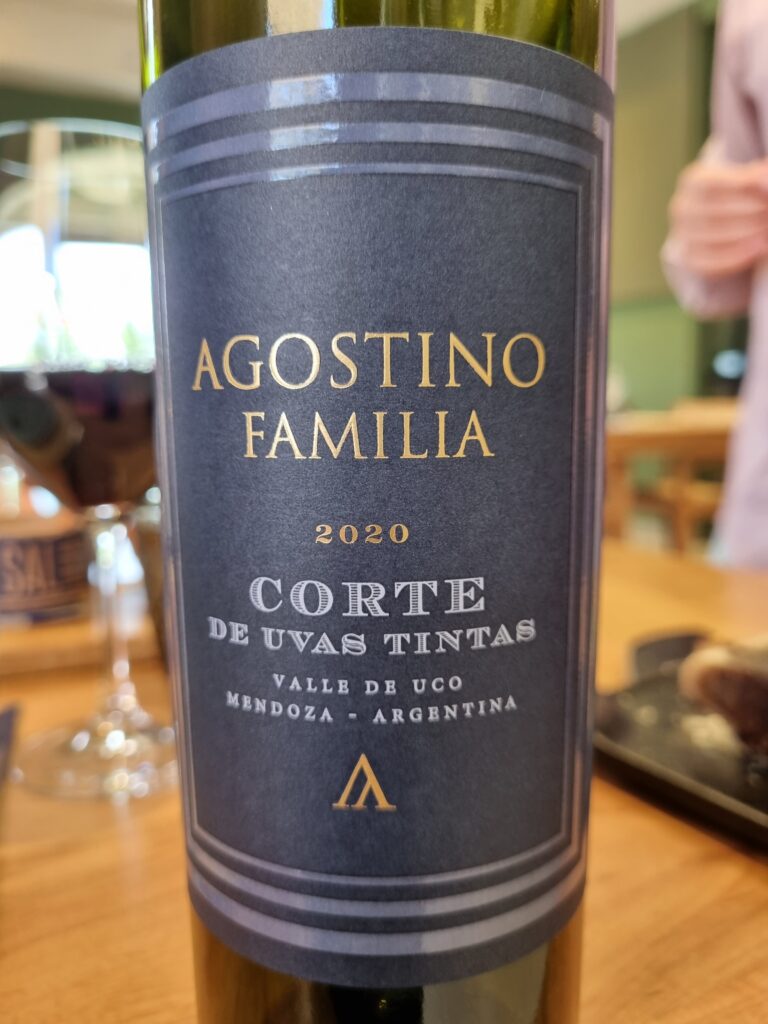
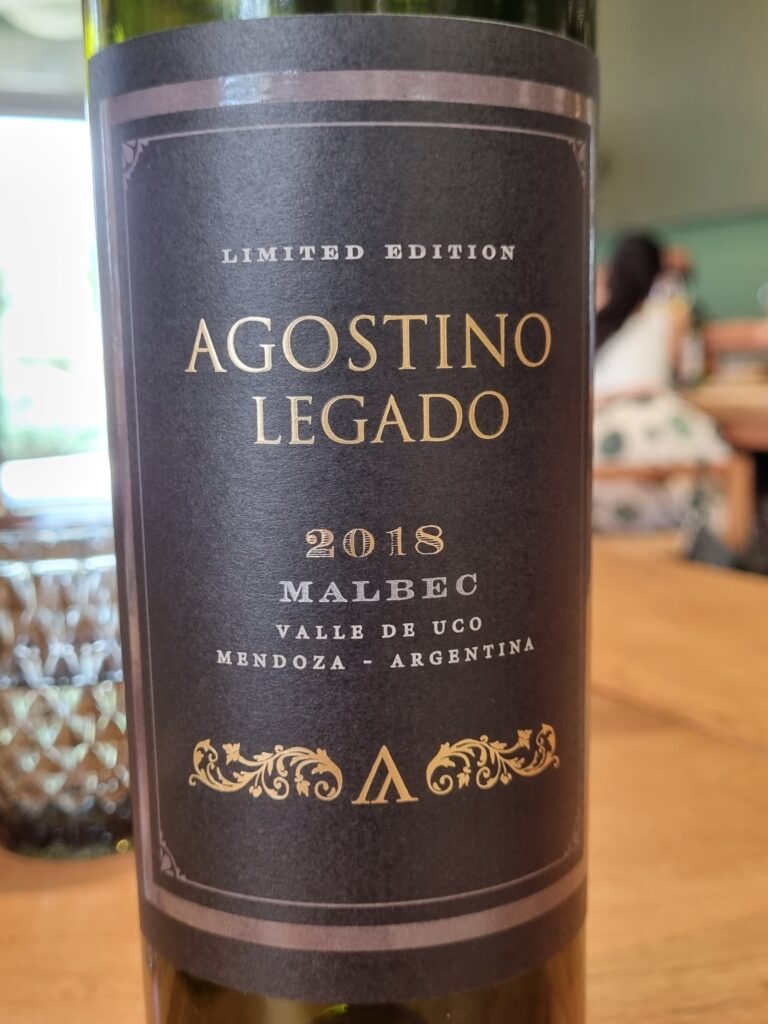
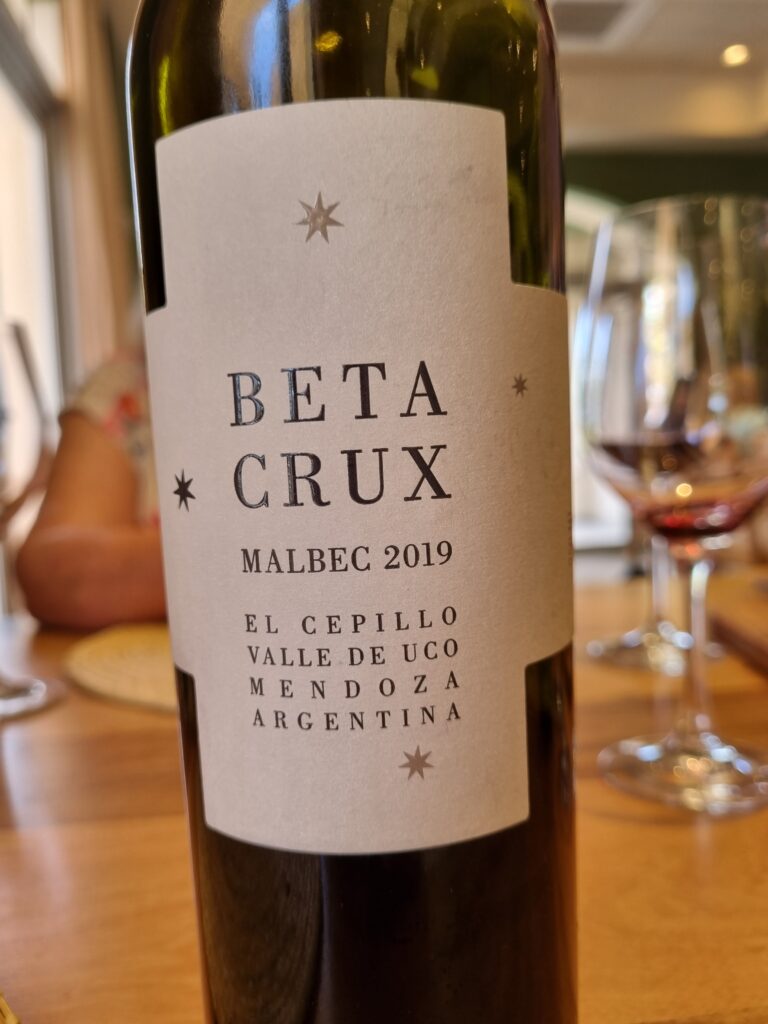
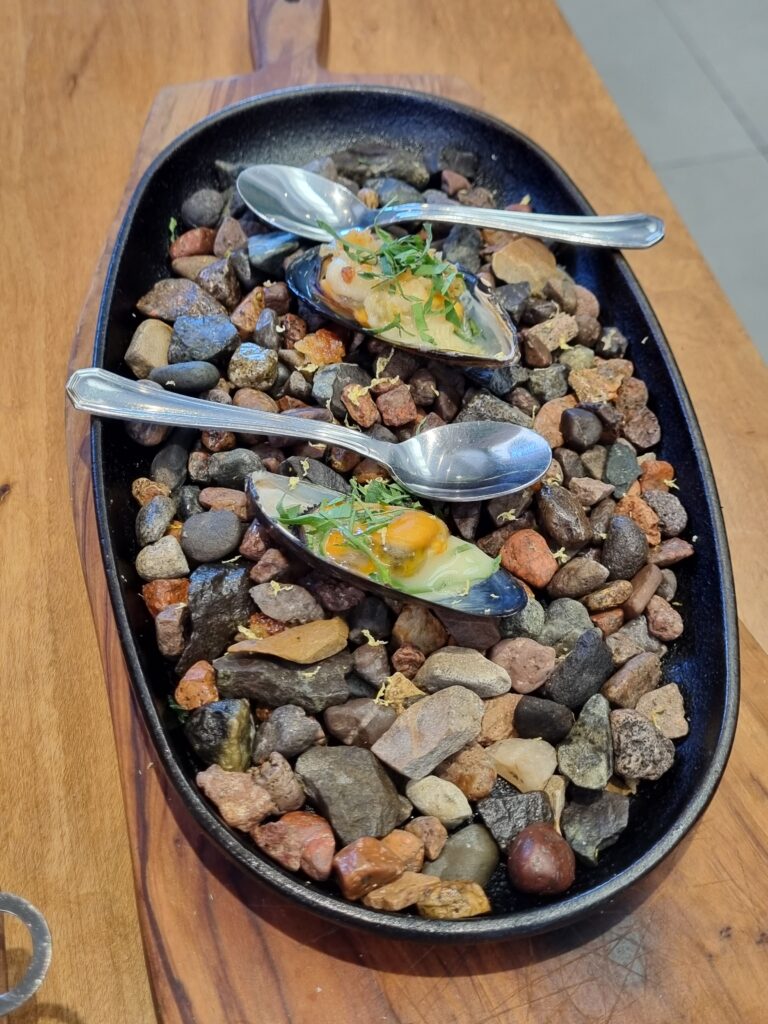
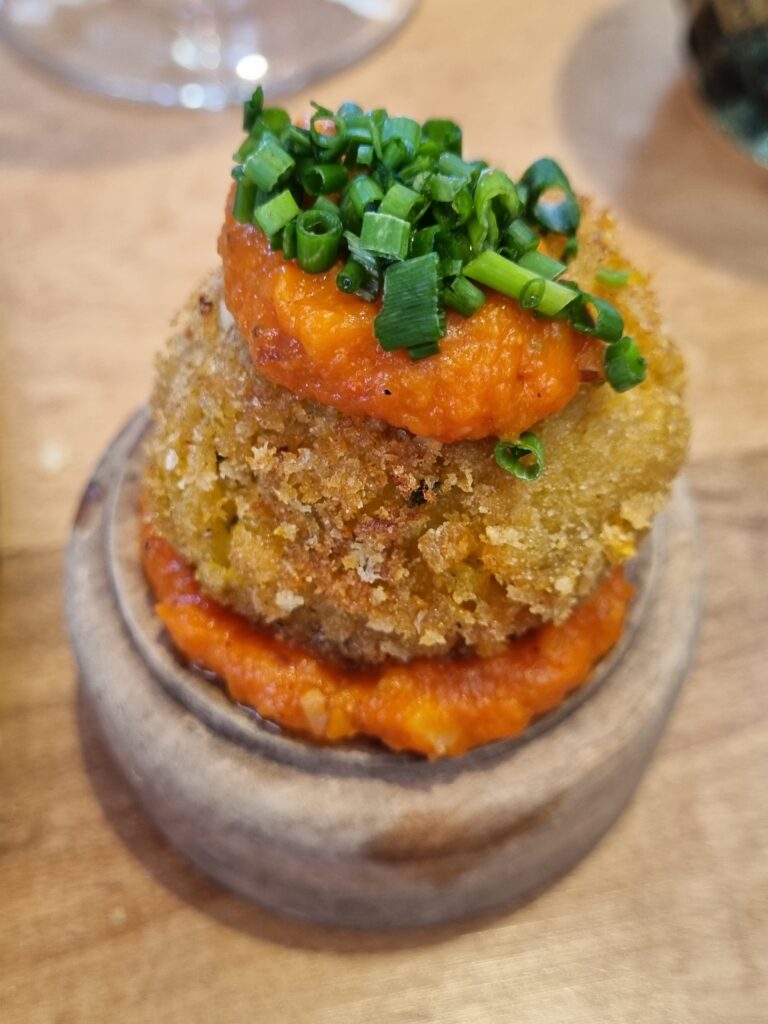
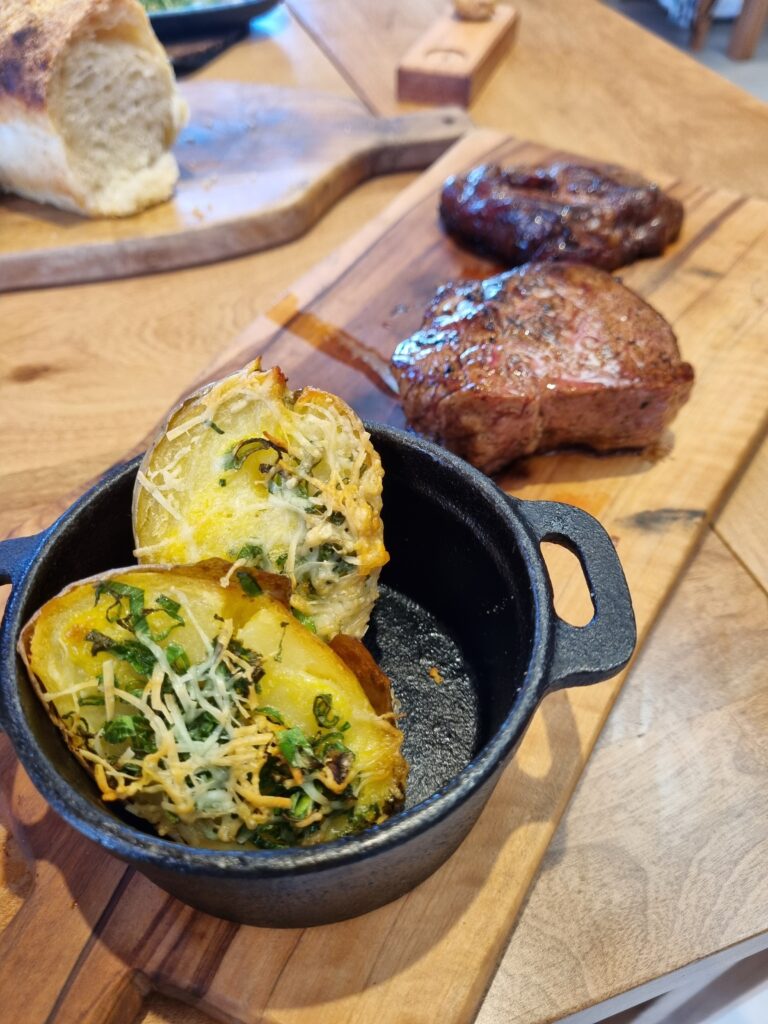
Agostino: This winery is located in the Barrancas region of Maipú, where the family firm have 305 hectares of vines. These grow on a former river bed with stony soil ideal for viticulture. We didn’t actually visit here and only came to eat lunch in their restaurant which was, by the way, up to the most exacting European standard. The 2020 Agostion Familia Corte de Uvas Tintas is a blend of Malbec, Cabernet Sauvignon, Merlot, and Tempranillo grapes from the Uco Valley. This was a nice introduction to the house style. It was fresh and fruity although the 15 year ageing potential mentioned on the back label should be taken with a grain of salt. The 2018 Agostino Legado Malbec, also from the Uco Valley, was a step up, with more structure and gravitas. We ended with the top of the line, the 2019 Beta Crux, a big oaky wine, but not without elegance.
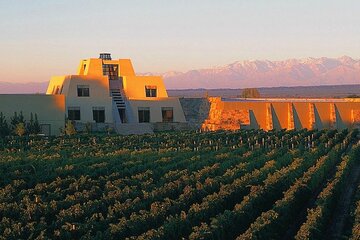
Cantena Zapata : This was one of the highlights of the trip. Built in 2001, the winery’s striking design was inspired by Mayan temples the owners had admired during a trip to Guatemala. Dating back to 1902, the family business developed out of all recognition in the late 20th century under the leadership of Nicolas Catena Zapata. He innovated on many fronts: clonal selection and propagation of his best Malbec vines, developing a reputation for quality Argentinian wine on export markets and, above all, planting at high altitudes (up to 1,500 meters) in order to produce fresher more balanced wines. Furthermore, he established a Wine Institute, which makes Cantena one of only a handful of producers in the world with their very own. The Adrianna vineyard, source of their top wines, is one of the most analysed in the world. Experimentation is never-ending. Nicolas’ daughter, Laura, now runs the show. She is a medical doctor with a degree in biology from Harvard who splits her time between San Francisco and Mendoza.
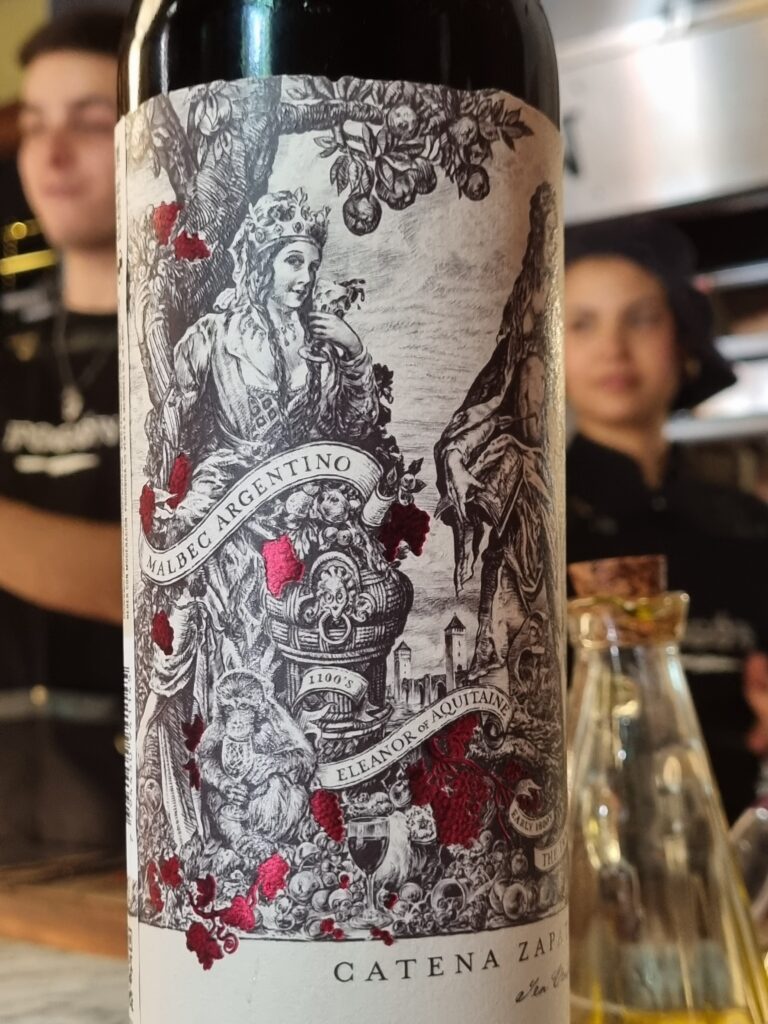
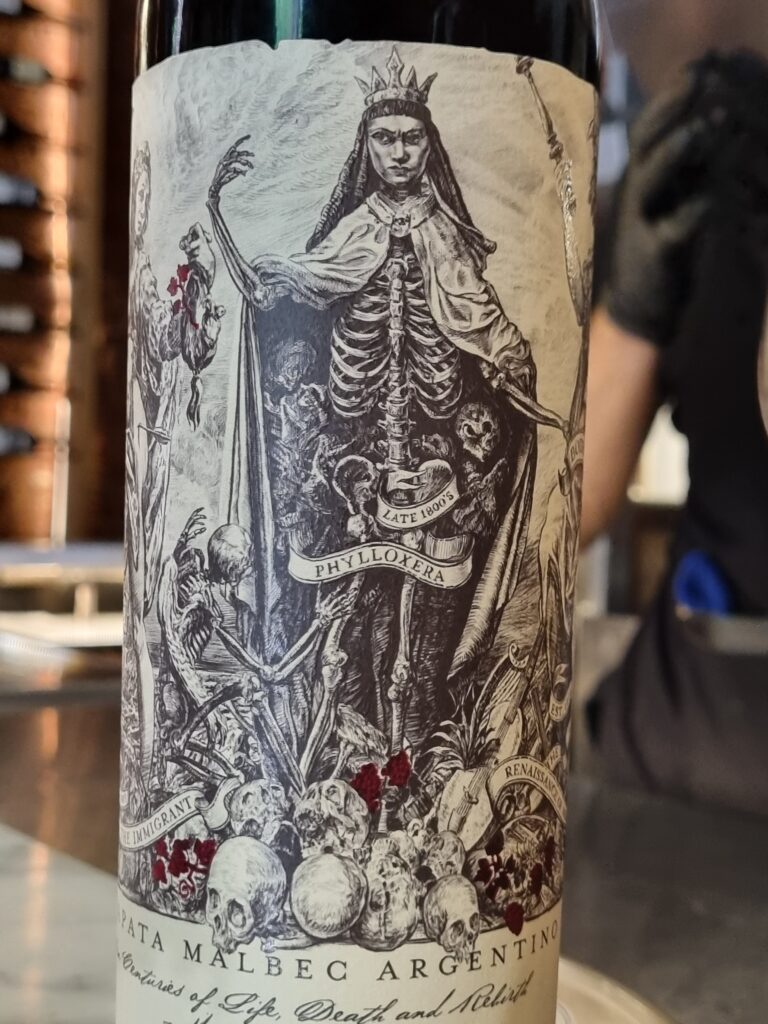
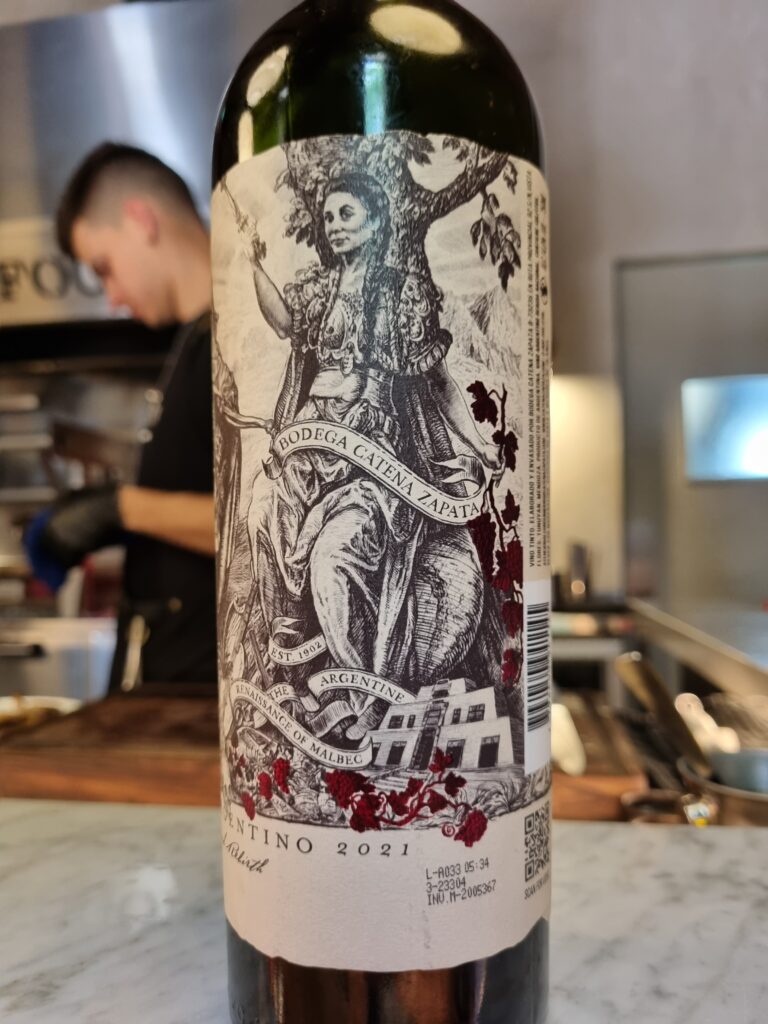
My wife and I tasted several wines with Fernando Buscema, Director of the Wine Institute and winemaker. The overall quality was really very good. We started with the impressive 2021 Malbec Argentino that we had already appreciated in Buenos Aires. The eye-catching label depicts four women involved with the history of Malbec including Eleanor of Aquitaine and Laura Cantena herself. The bouquet was sweet and Italianate with chocolate nuances and subtle toasty oak (the wine is barrel fermented and aged). It was full-bodied, strapping, and had a long leathery finish.
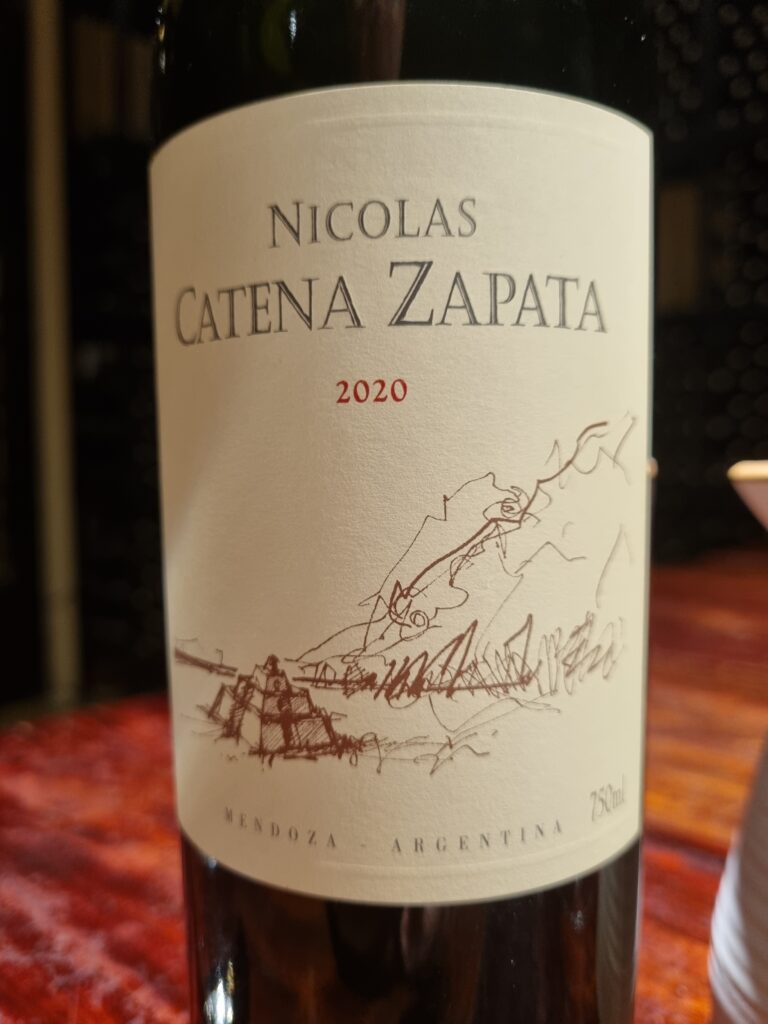
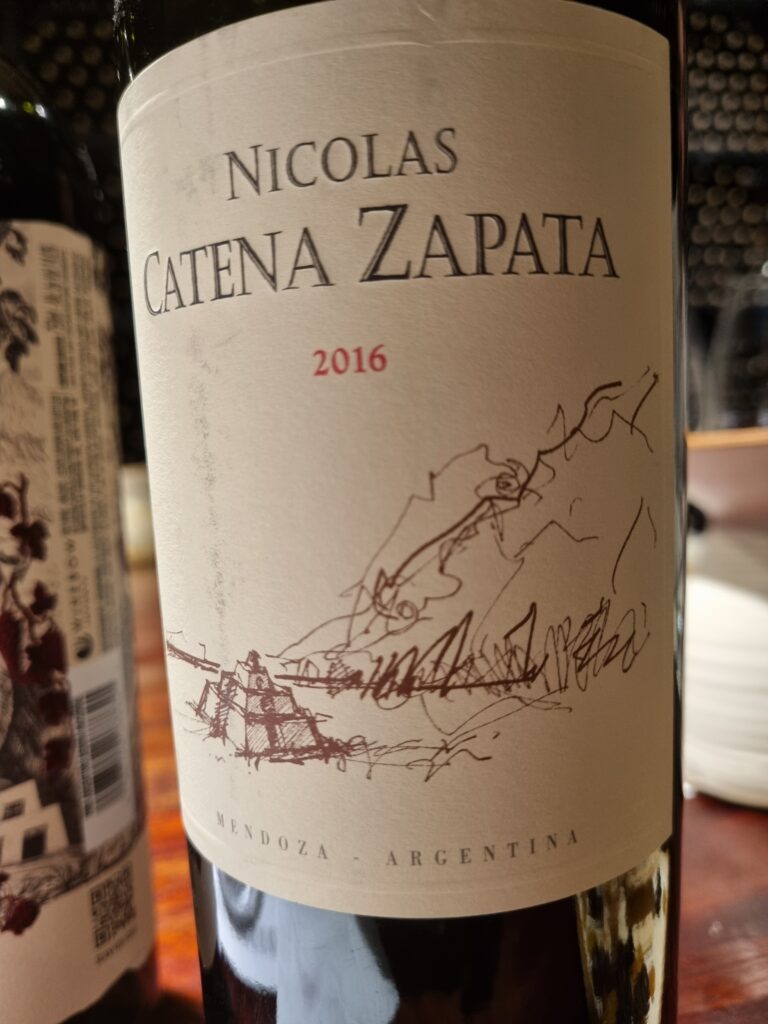
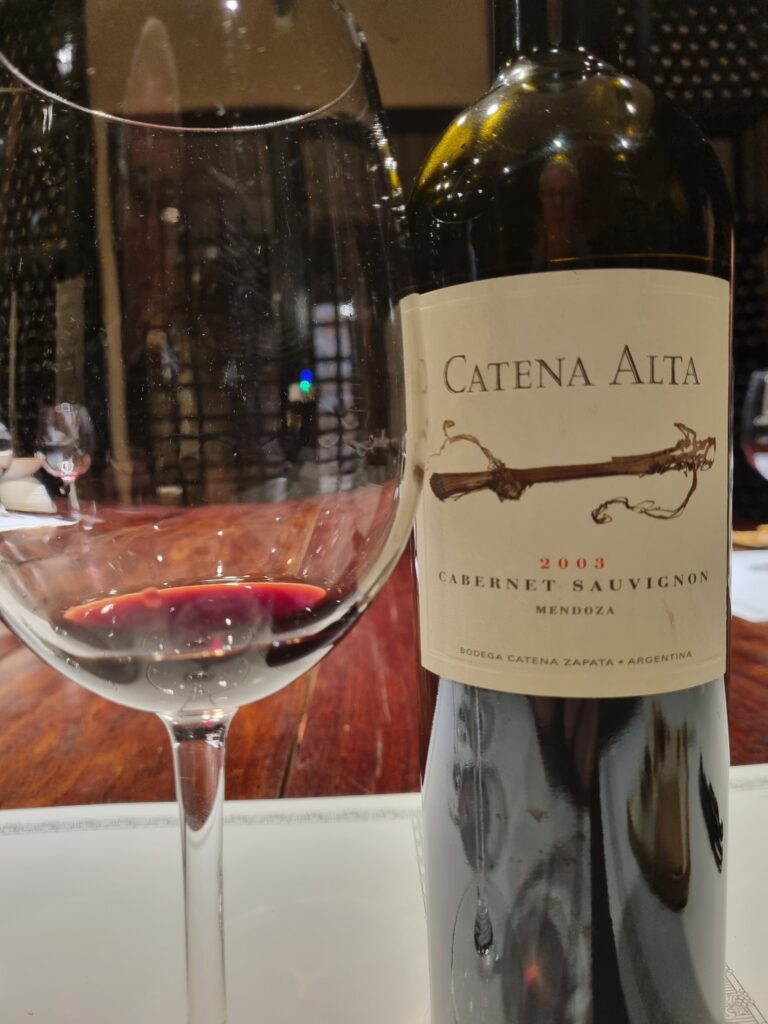
We then tasted the 2020 and 2016 vintages of Nicolas Cantena Zapata (one of two wines sold on the Place de Bordeaux), consisting of 40% Cabernet Sauvignon, 30% Malbec, and 10% Cabernet Franc. I preferred the 2017, with graphite on the nose along with soft plummy aromas and trademark Malbec floral notes. It was Pomerol-like on the palate with a tarry sweet finish. A very fine wine by anybody’s reckoning. We finished with one of the rare old wines we were to taste on our trip, a 2003 Cantena Alta. The purpose was to show us that Argentinian wines have staying power, and we did indeed come away convinced.
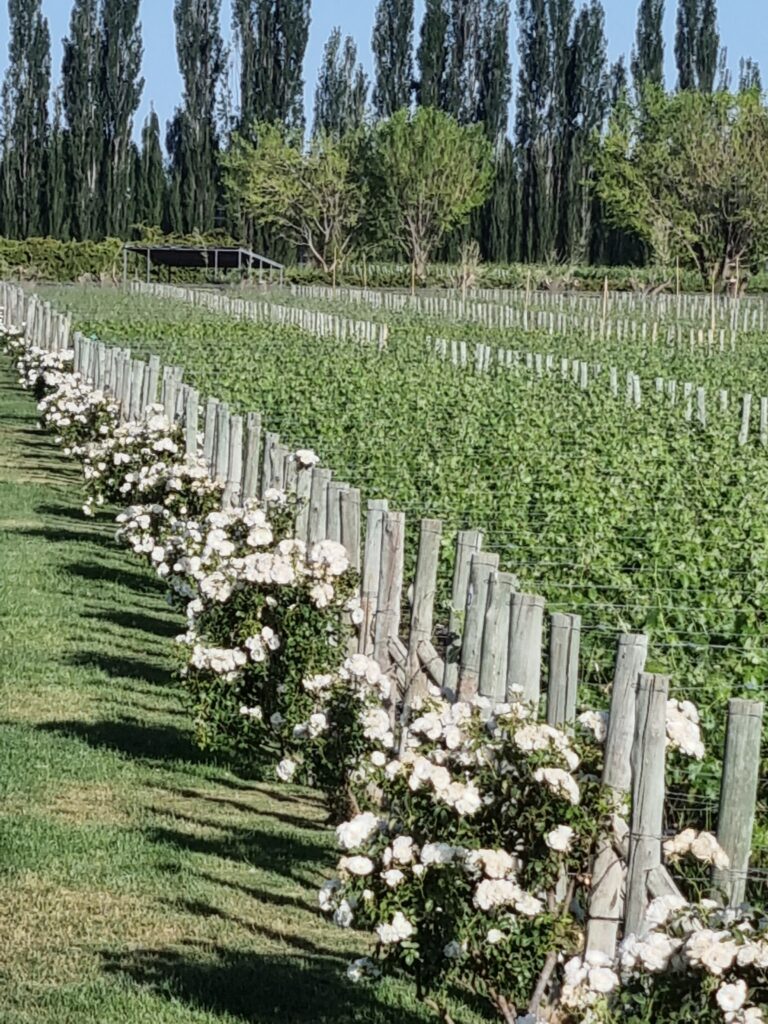
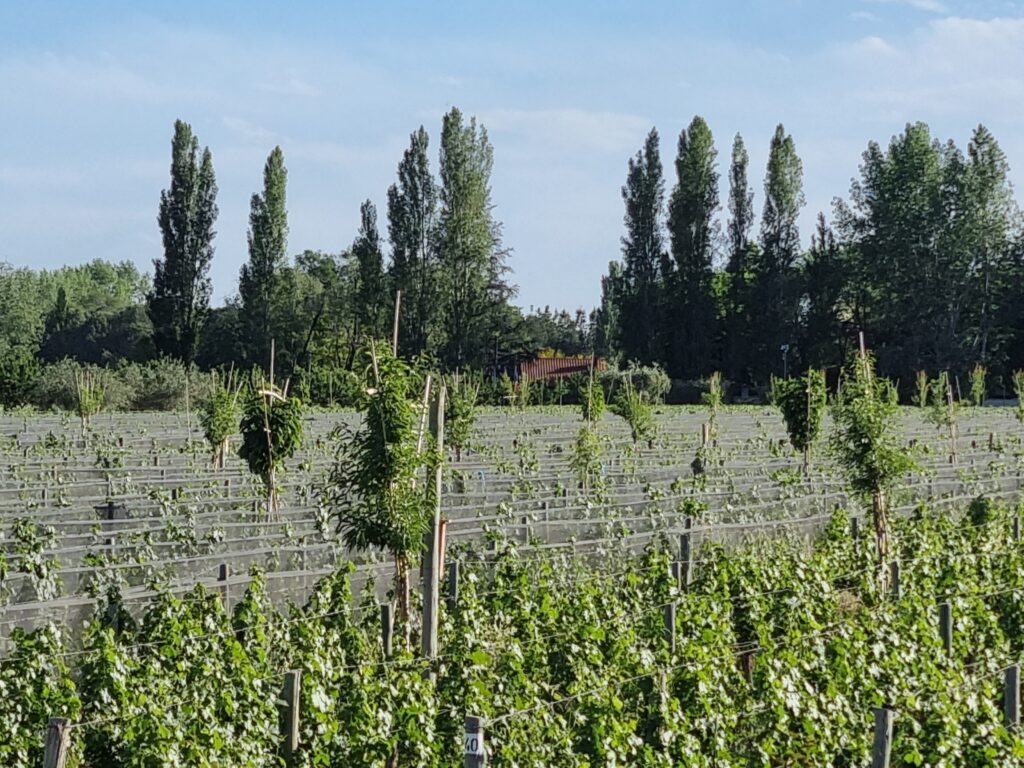
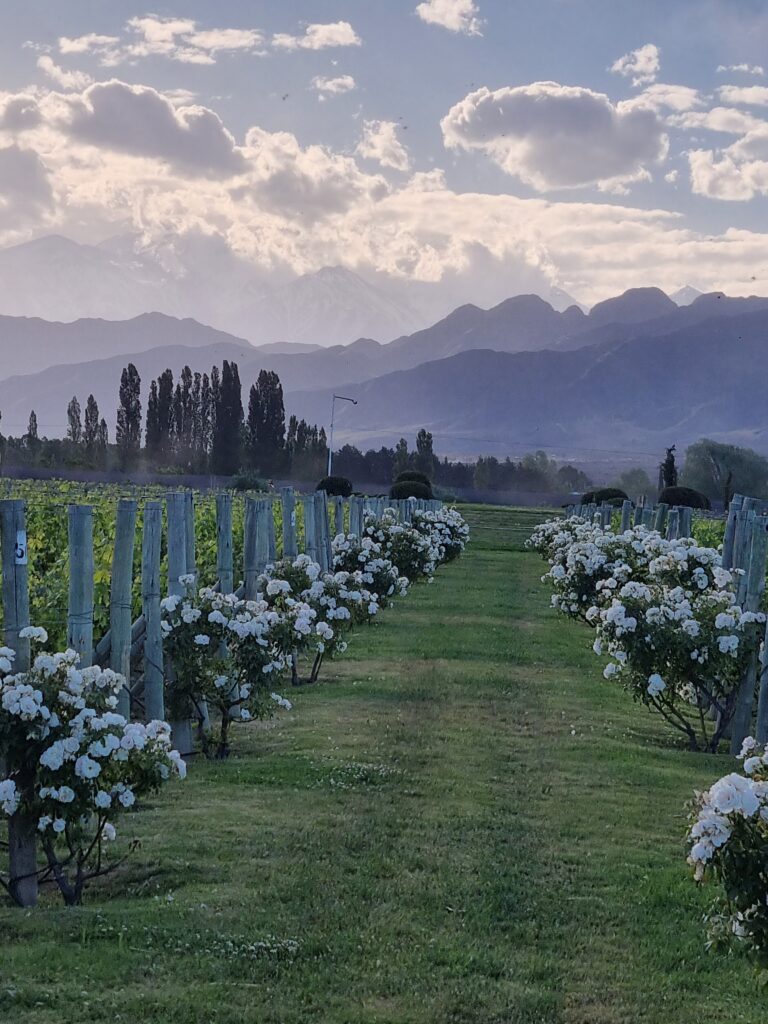
Cheval des Andes: This was one of the wineries I really wanted to visit, so I wrote an e-mail to Pierre-Olivier Clouet at Château Cheval Blanc in Saint Emilion to ask if he could arrange this since the two estates have shared ownership (Bernard Arnault/LVMH). Almost immediately, I received an e-mail from Gérald Gabillet in Argentina inviting me to visit and also to stay for dinner, which I thought was pretty amazing.
Cheval des Andes in Lujan de Cuyo is a young, but not exactly new estate since their first vintage was in 1999. The wine has, until now, been made at nearby Terrazas Los Andes, another star in the LVMH constellation. However, this is about to change because a new winery is being planned on site. I discovered this at dinner because several architects were there visiting from France. And much to my surprise, the team from Château Cheval Blanc was there as well! So there we were there in a very French context enjoying a barbecue and drinking Cheval des Andes – an incredible experience.
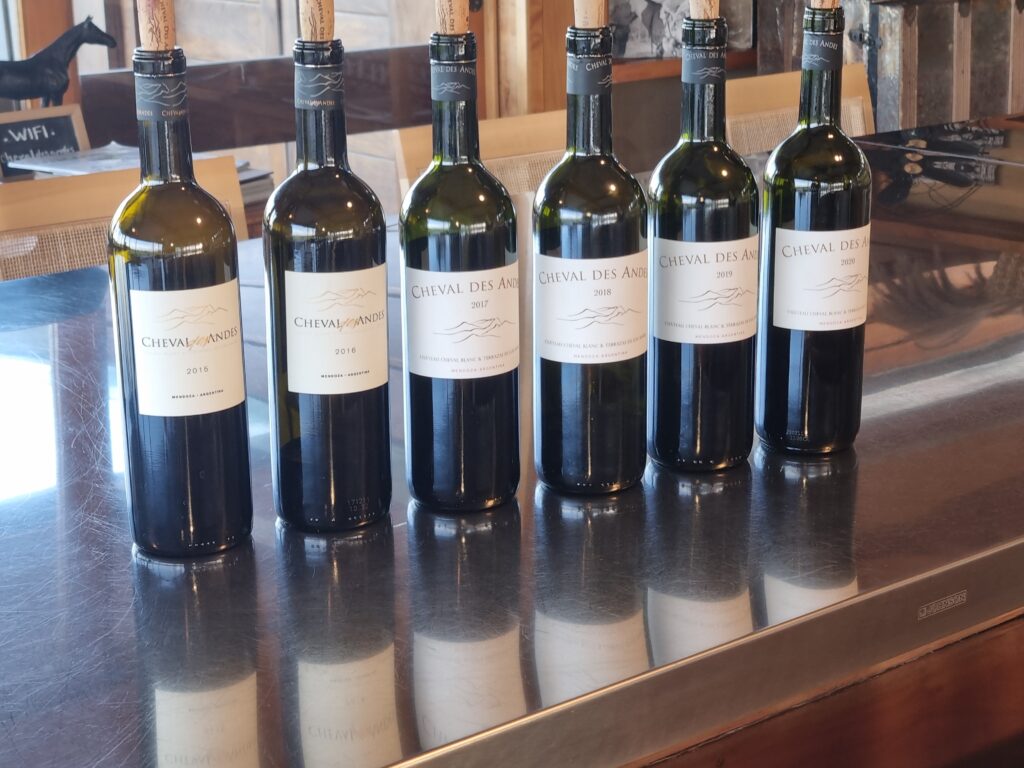
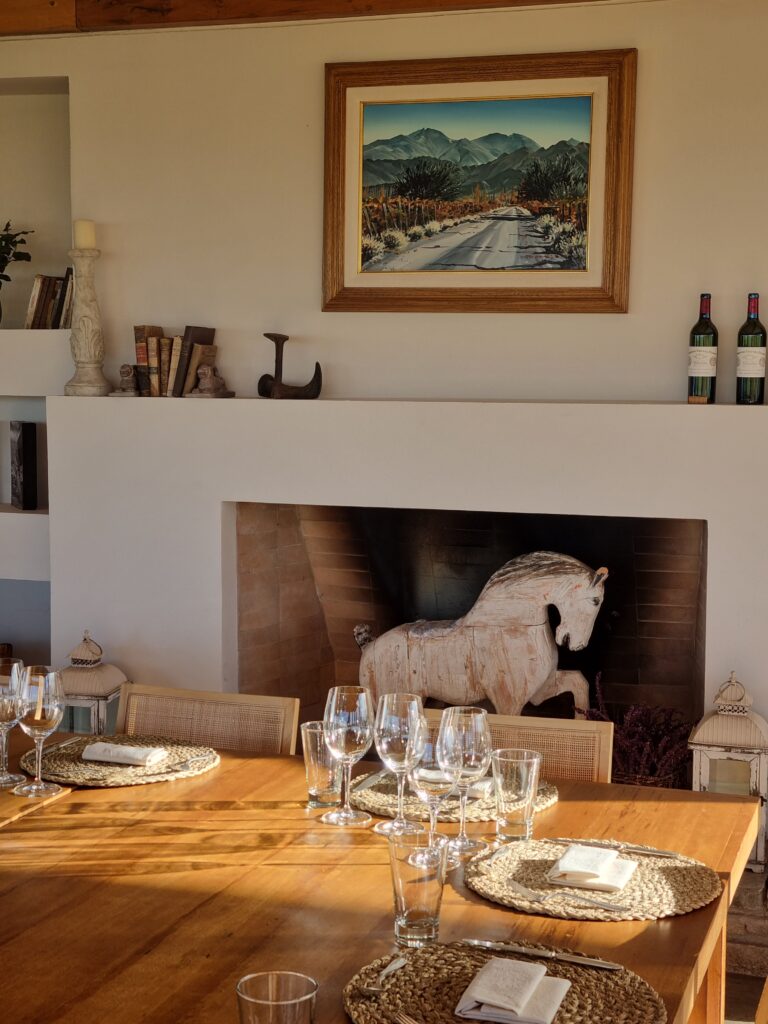
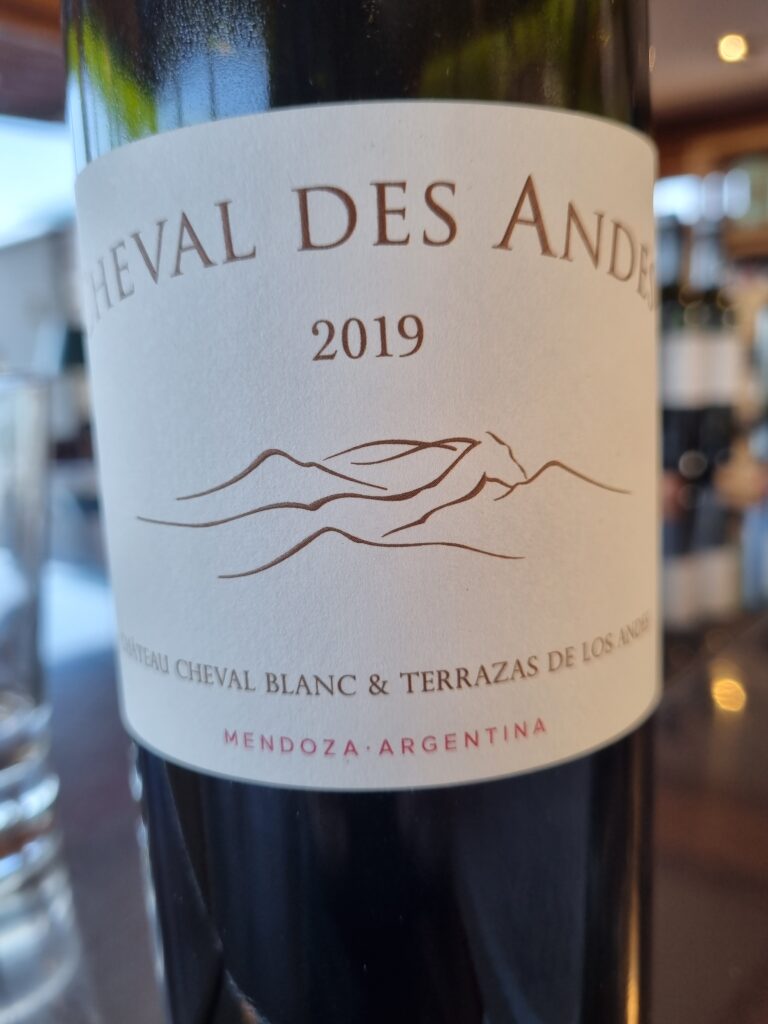
Cheval des Andes’ 50-hectare vineyard is in an idyllic location, with roses planted at the end of vine rows, a small lake and, in keeping with a new trend in Bordeaux, fruit trees planted between vine rows (agroforestry). The effect is really very striking. The soil consists of sand (36%), limestone (48%) and clay (16%). Stones at a depth of 1.5-2,5 meters add minerality to the wine. I was privileged to do a vertical tasting of the 2015, 16, 17, 18, 19, and 20 vintages. Without transcribing my tasting notes in detail, let me say that Cheval des Andes is well on the well toward realizing their ambition of “South American grand cru” status. I particularly liked the 2017 with hints of graphite on the soft plummy nose. The wine was poised and elegant on the palate with plenty of character and Malbec’s finer floral characteristics. This variety accounts for nearly 60% of the blend, the rest mostly Cabernet Sauvignon and a little Petit Verdot.
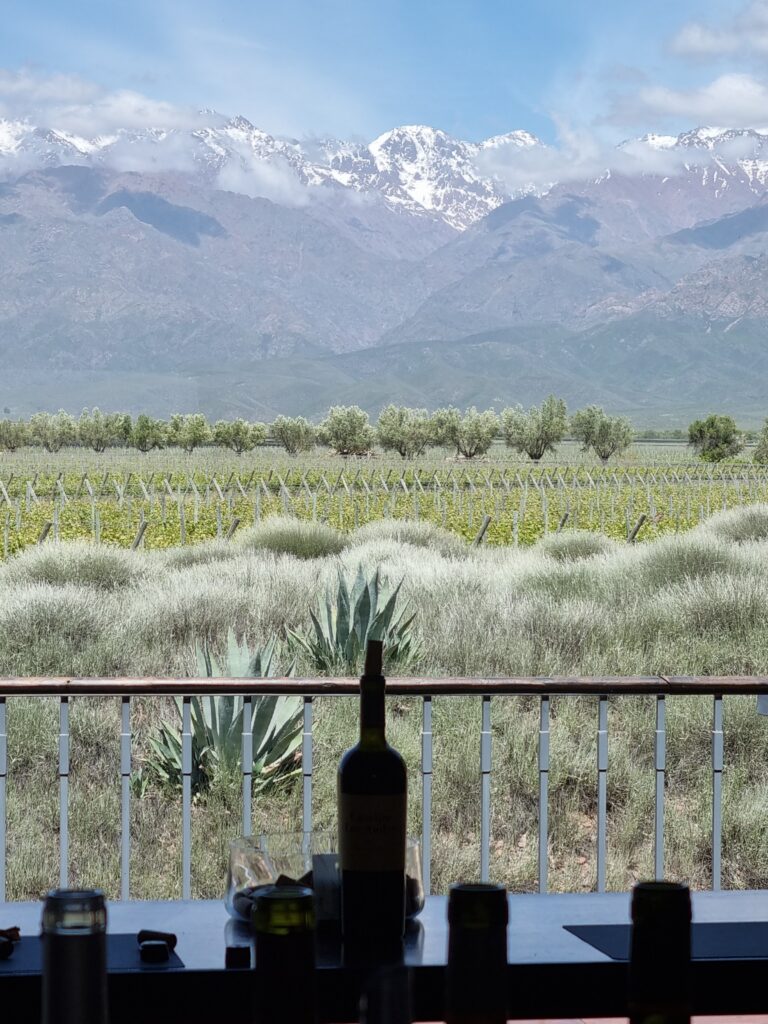
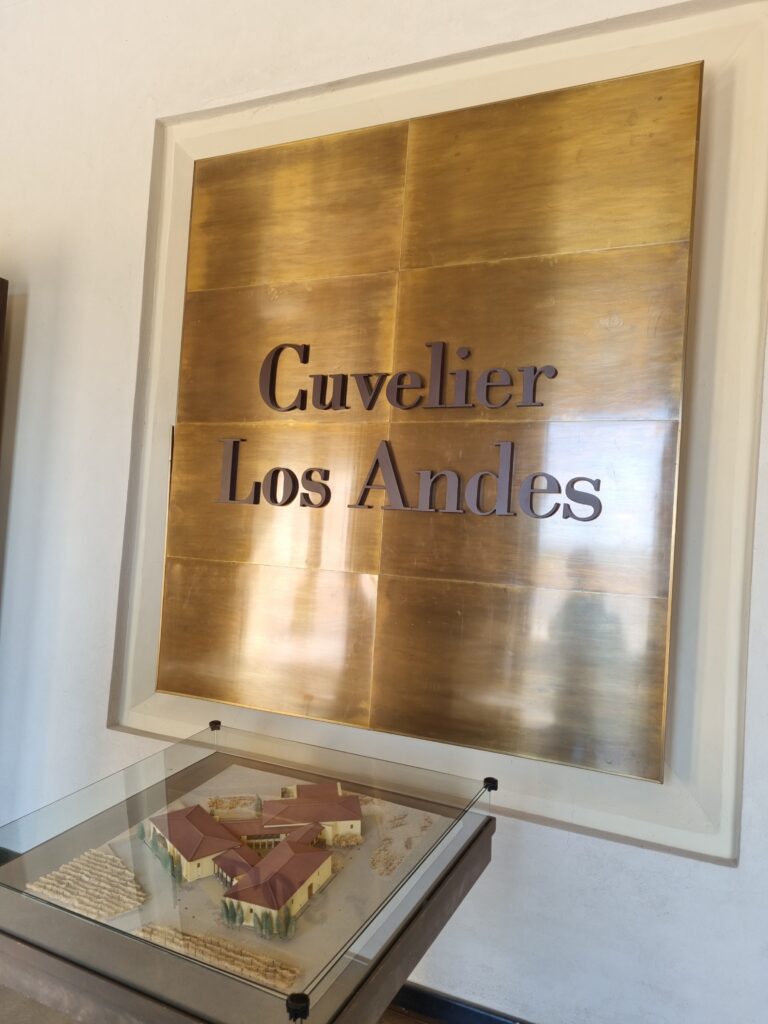
The next day was spent in the Uco Valley, about a 2 ½ hour drive from Mendoza. One of the region’s great successes is Clos de los Siete, the brainchild of Bordeaux’s Michel Rolland. He started coming to Argentina as a consultant in the 1980s and saw an opportunity to buy a huge (850-hectare) tract of land with good winegrowing terroir (higher altitude than elsewhere in Mendoza) in the late 1990s. He and six other wine families each bought part of the estate to make their own wine and to contribute part of their production to the Clos de les Siete brand, which amounts for over a million bottles a year. The first vintage was in 2002. Other members include the Péré Vergé/Parent family of Châteaux Le Gay and La Violette in Pomerol, the Cuvelier family of Château Léoville-Poyferré, the Bonnie family Bonnie of Château Malartic-Lagravière, and the Rothschilds of Lafite (who have since left the consortium, but continue to make their own wine within the Clos).
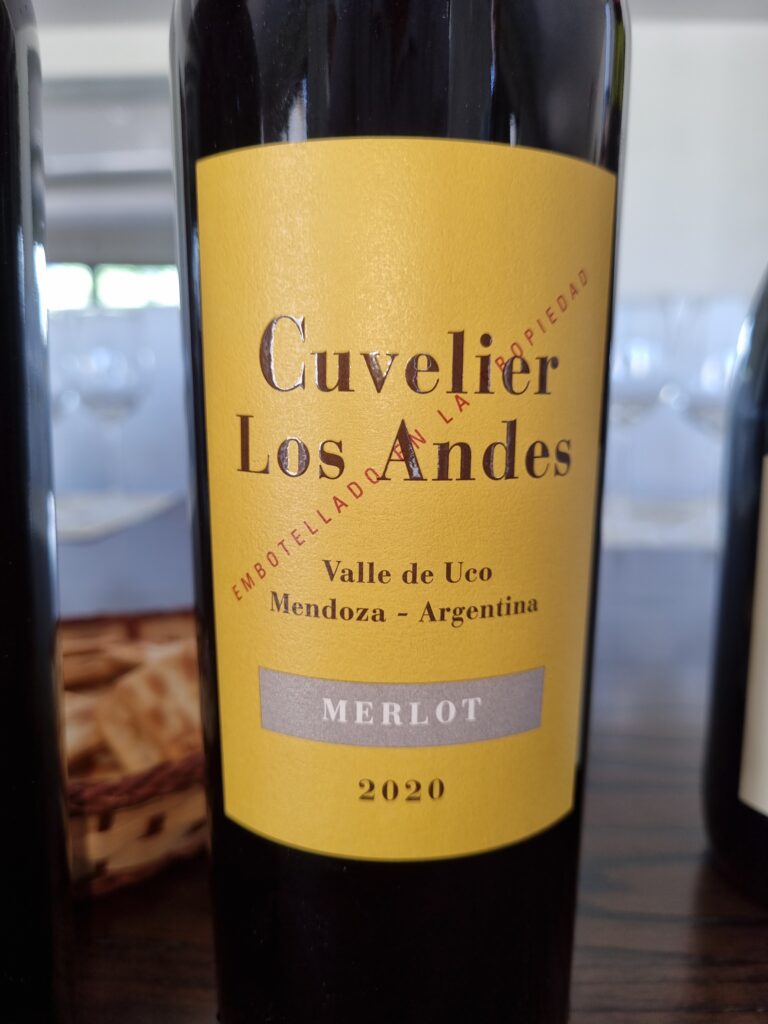
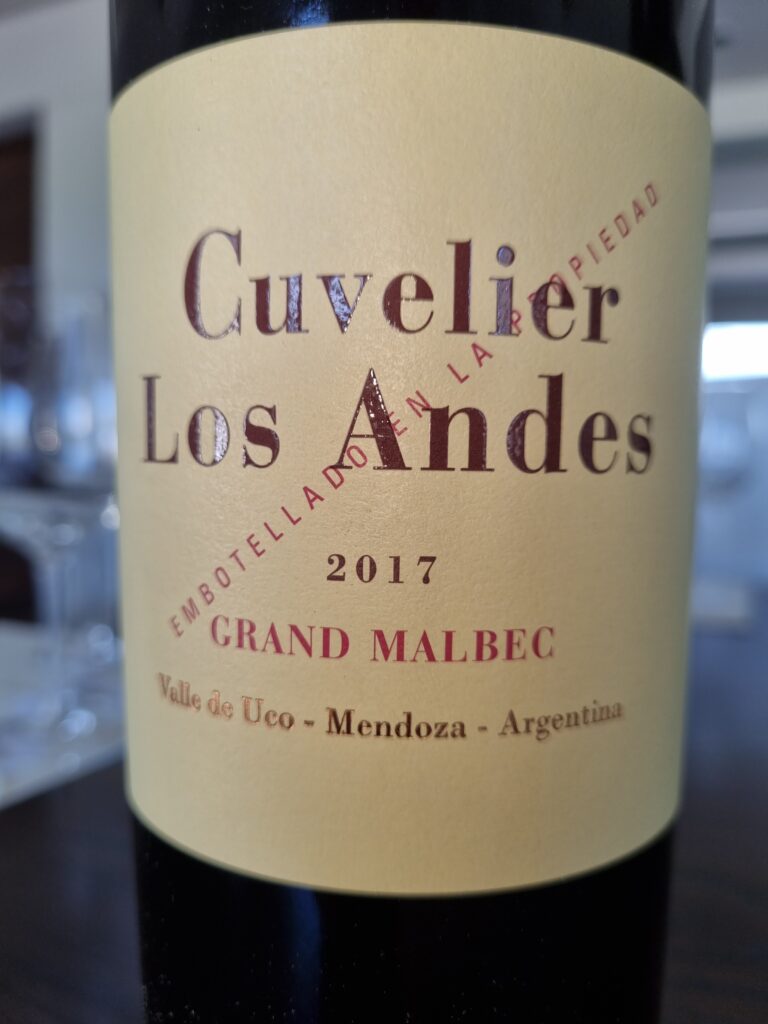
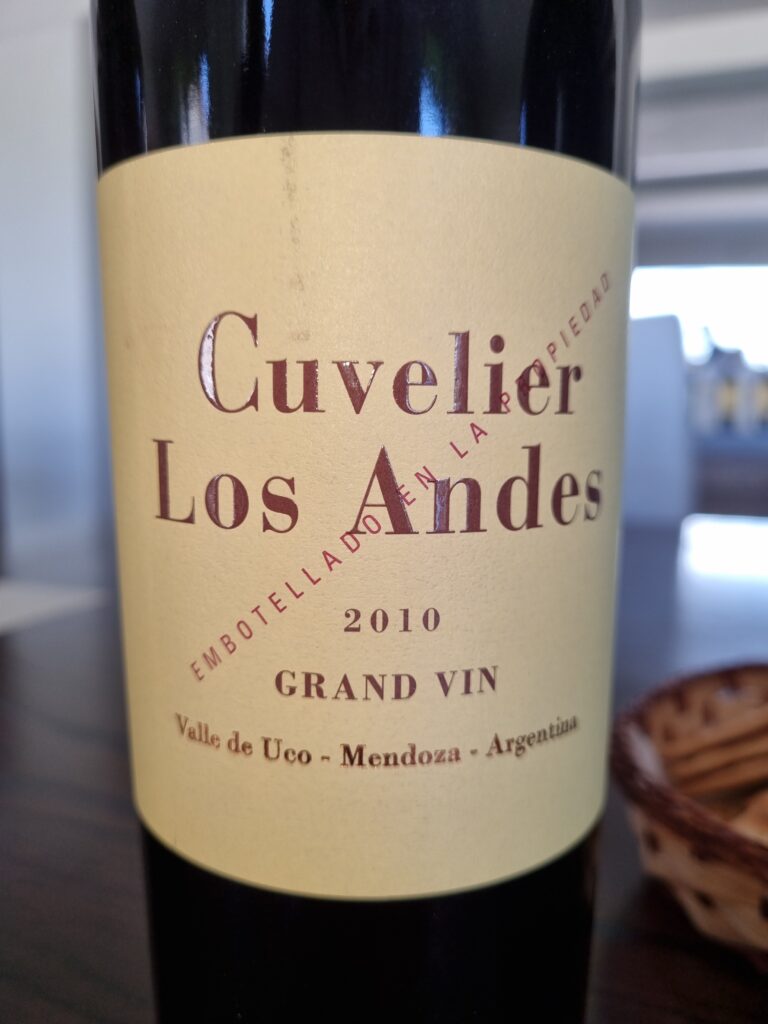
We were once again very much in a French environment at Cuvelier Los Andes, where Argentinean winemaker Adrian Manchon took us around the modern well-equipped winery in the French language. Cuvelier Los Andes has 55 hectares of vines (Malbec, Merlot, Petit Verdot, and Petit Verdot) grown organically a stone’s throw from the Andes foothills.
Founded by Bertrand and Jean Guy Cuvelier, the estate dates from 1999. Bertrand’s sons Mathieu and François-Xavier are now in charge. Much about the winery is reminiscent of Bordeaux and the labels of the top wines are close to that of Léoville Poyferré. Bertrand and Evelyne Cuvelier were there when we visited and kindly invited us to stay for lunch, at which time we drank the wines we had sampled at the tasting. The ones I liked most were the 2010 Grand Vin and the 2017 Grand Malbec. The latter had a deep bouquet and a taste profile like an elegant Zinfandel.
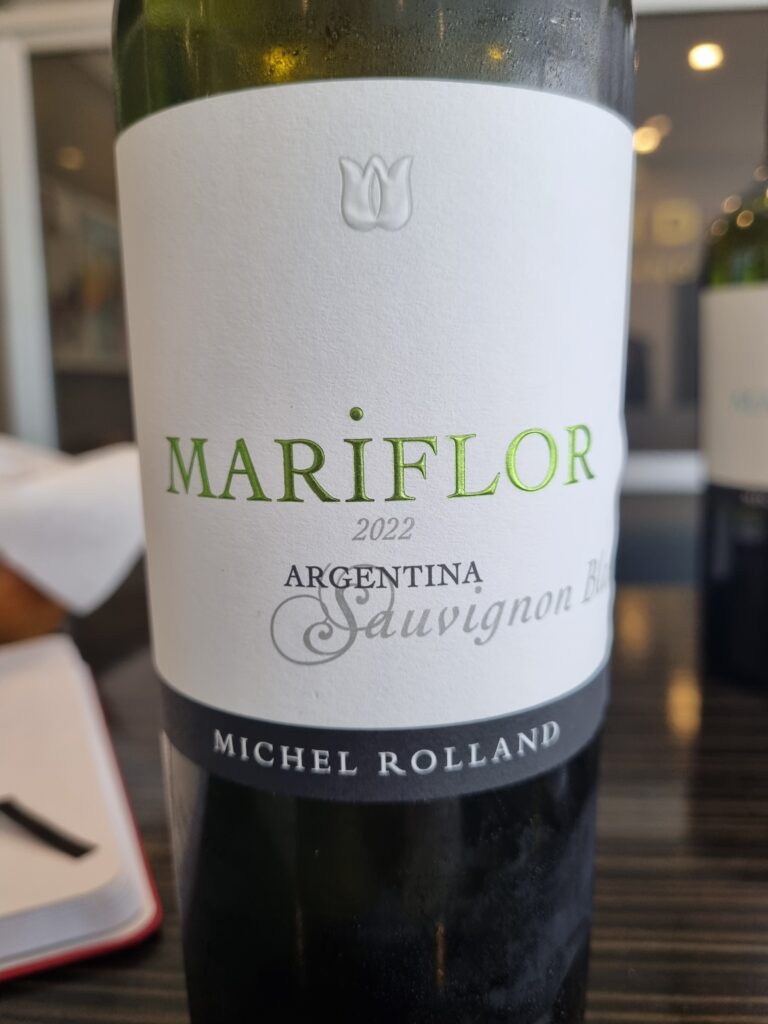
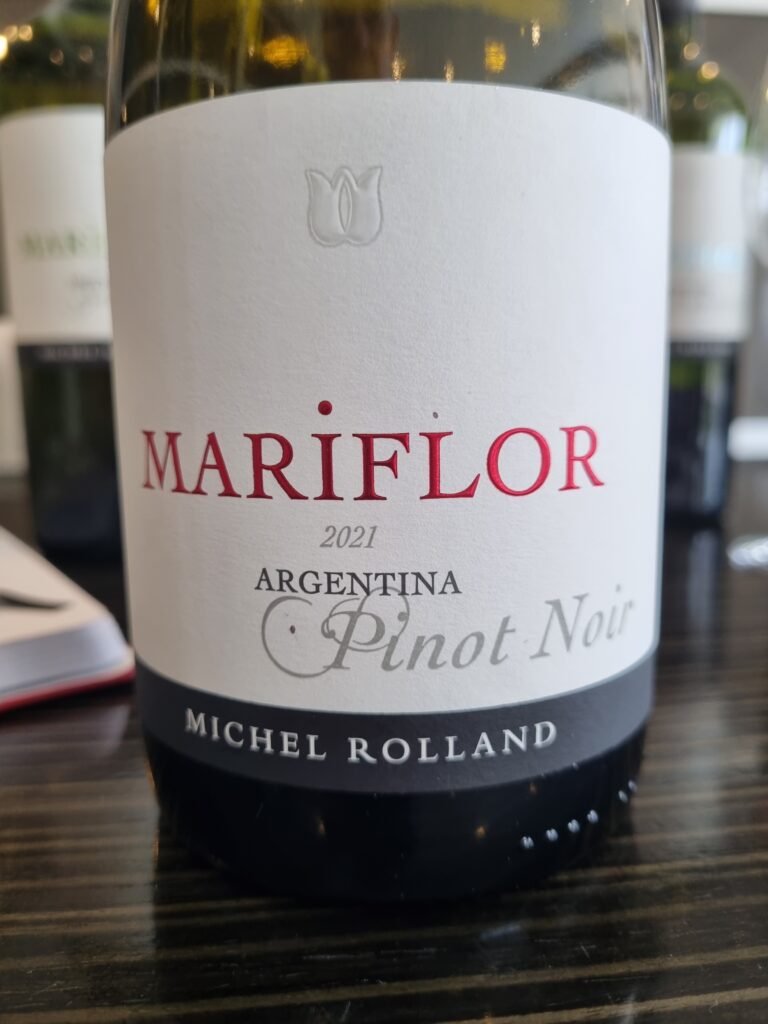
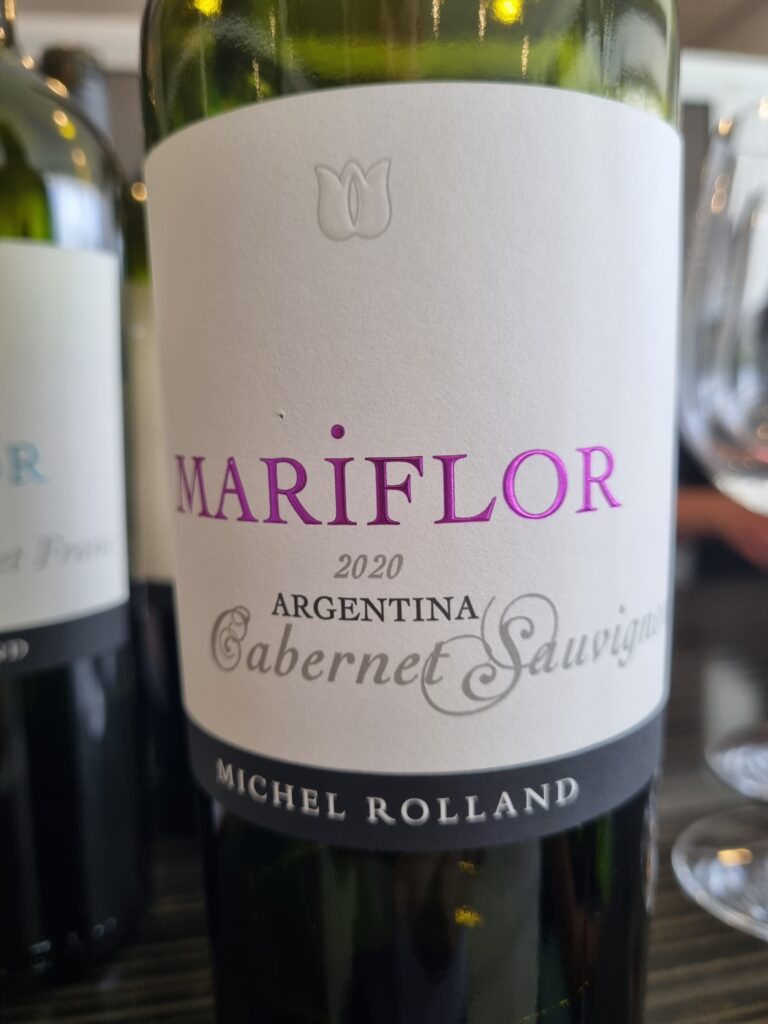
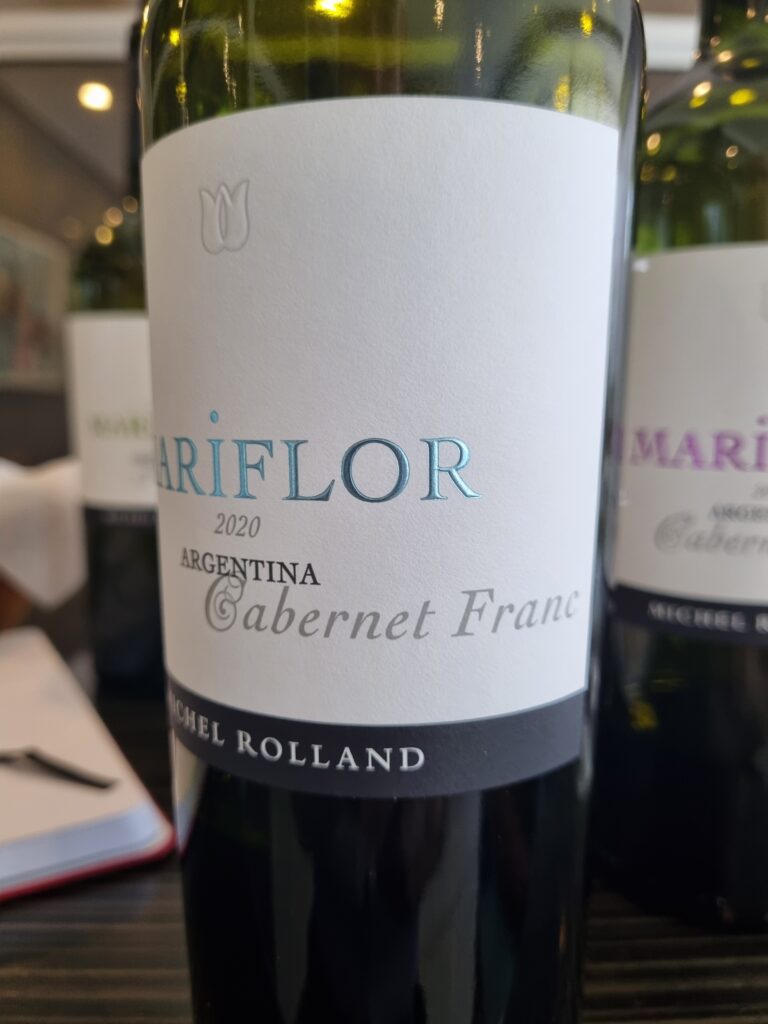
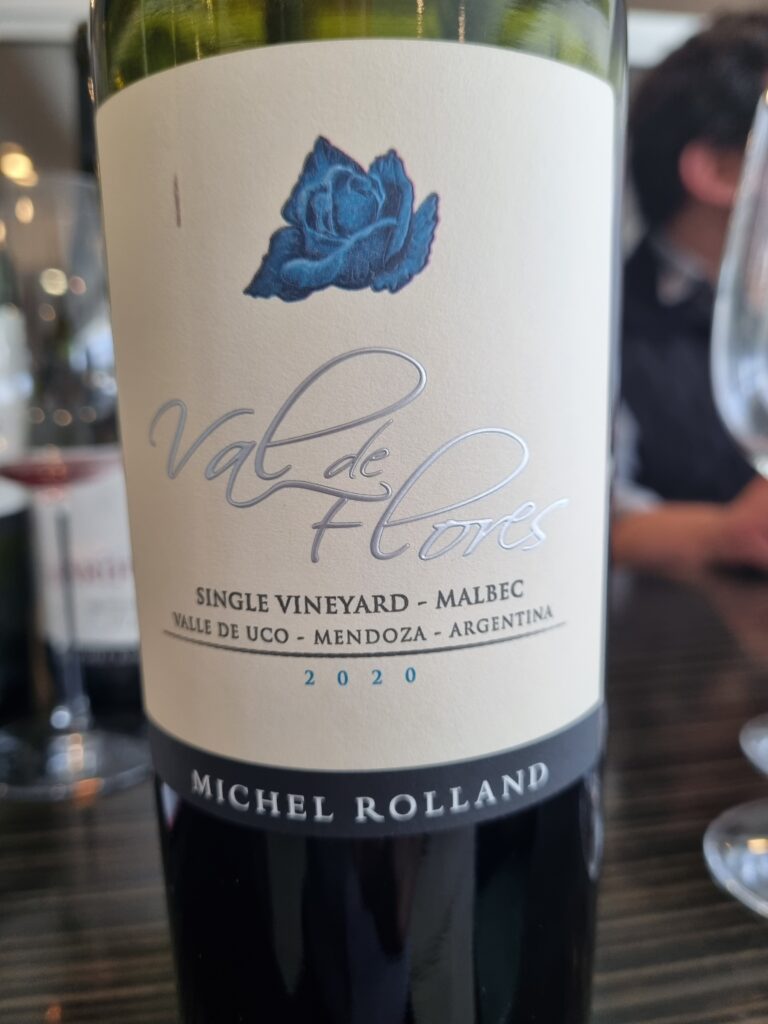
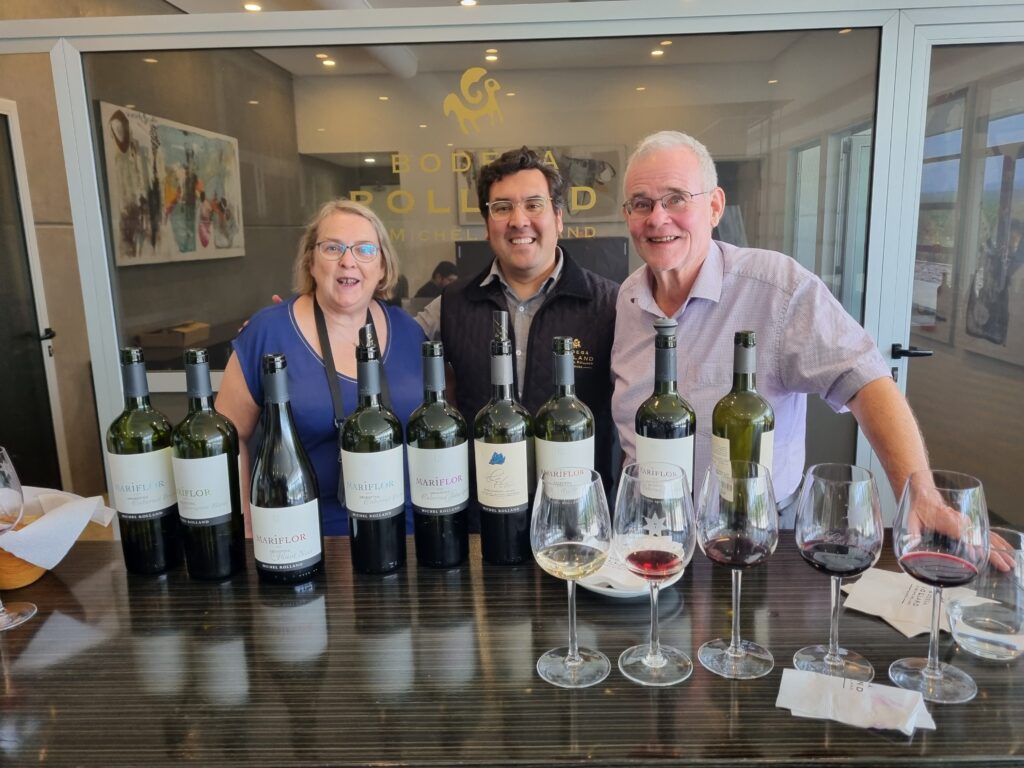
The second winery we visited in Clos de los Siete was Michel Rolland’s own.
Rolland is a controversial character, praised to the skies by some for improvements to modern oenology in Bordeaux and vilified by others for his supposed responsibility in the making of high-alcohol, heavily-extracted, over-oaked Bordeaux.
I have no prejudices one way or the other and no axe to grind with Mr. Rolland, but I must say that I came away very disappointed by his Argentinian wines. I tasted Bodega Rolland’s 2022 Sauvignon Blanc, 2021 Pinot Noir, 2020 Cabernet Sauvignon, 2020 Cabernet Franc, and 2020 Single Vineyard Malbec. These were sound and well-made, but soulless, with little evidence of terroir. They were also very expensive.
Our last day in Mendoza started with a visit to Huarpe winery in Agrelo, in the Lujan de Cuyo department. The name Huarpe pays homage to the indigenous people who, alas, no longer exist.
We saw llamas grazing in a field across from the winery, which added a rather exotic touch. Huarpe is a medium-sized modern winery (40,000 cases a year) belonging to two brothers, Max and José Toso who inherited a long winemaking from their Italian ancestors. The winery dates from 2003. They have vines in the Agrelo, Maipu, and Uco regions. The soil in Agrelo consists of sandy loam over gravel.
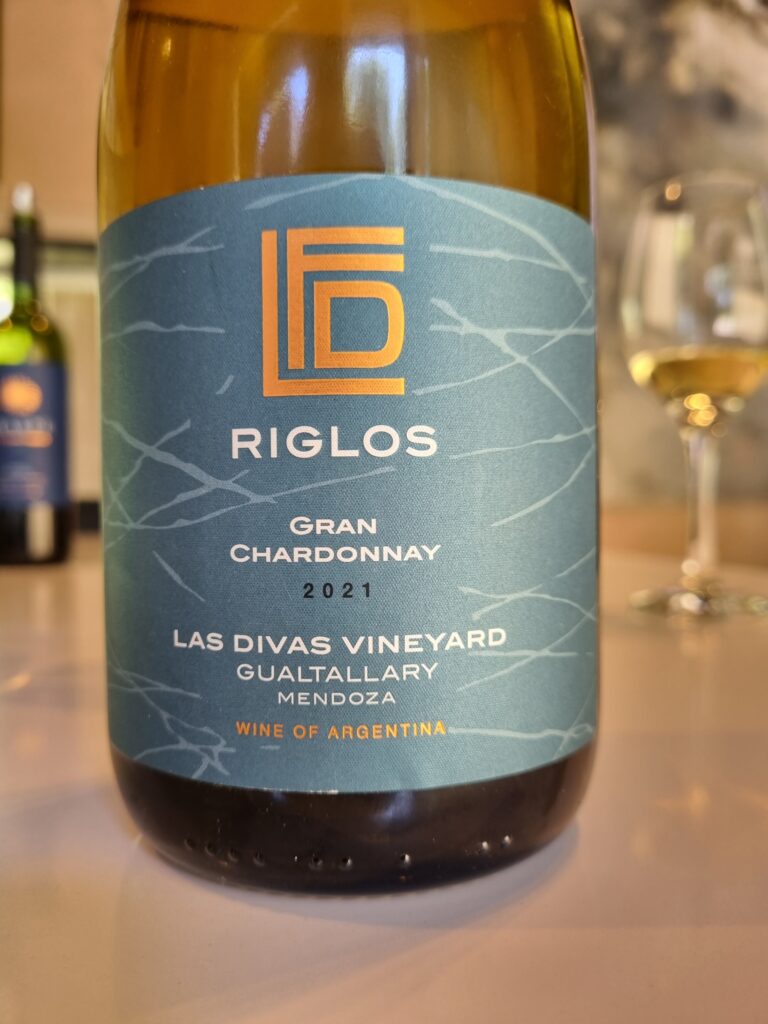
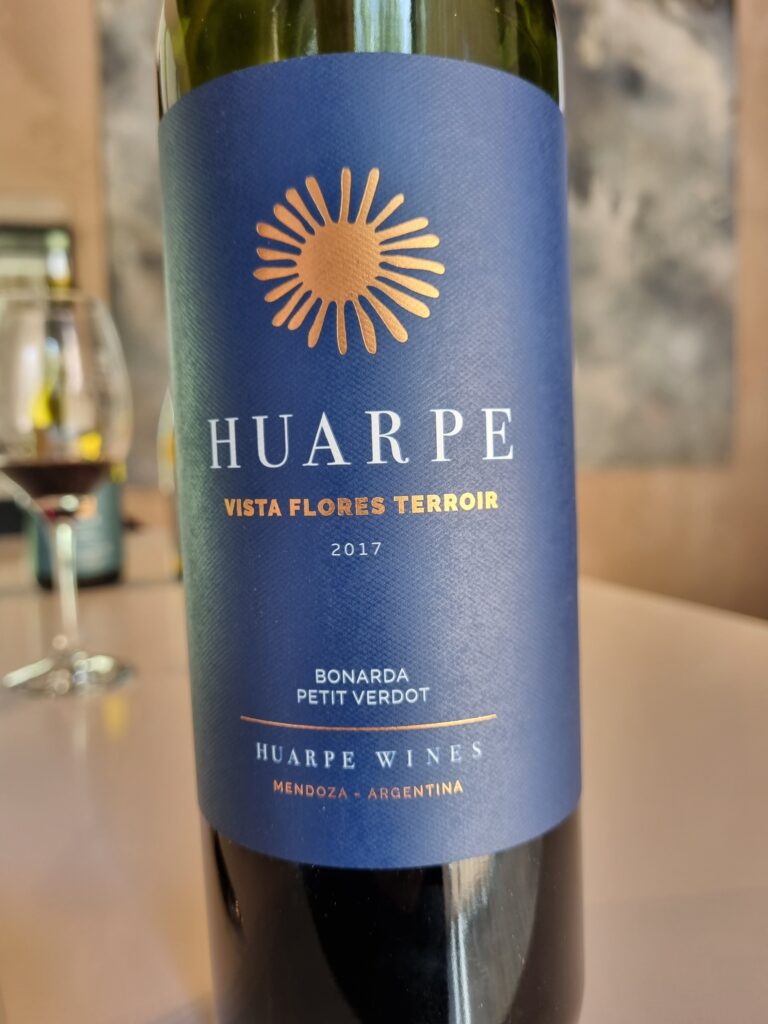
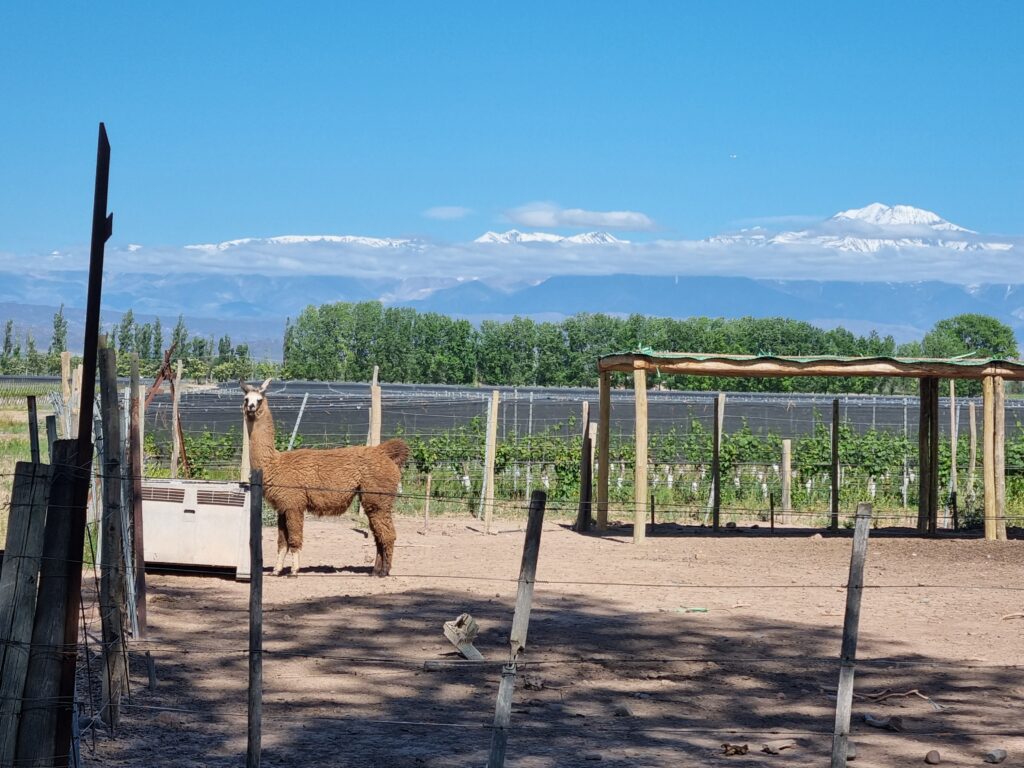
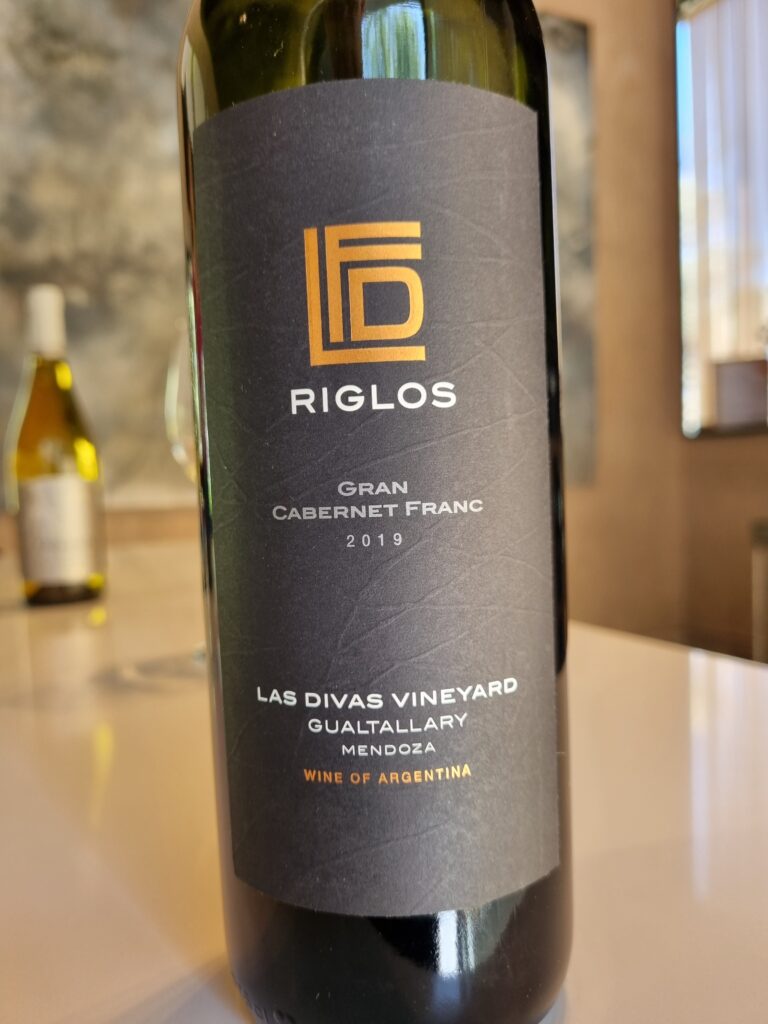
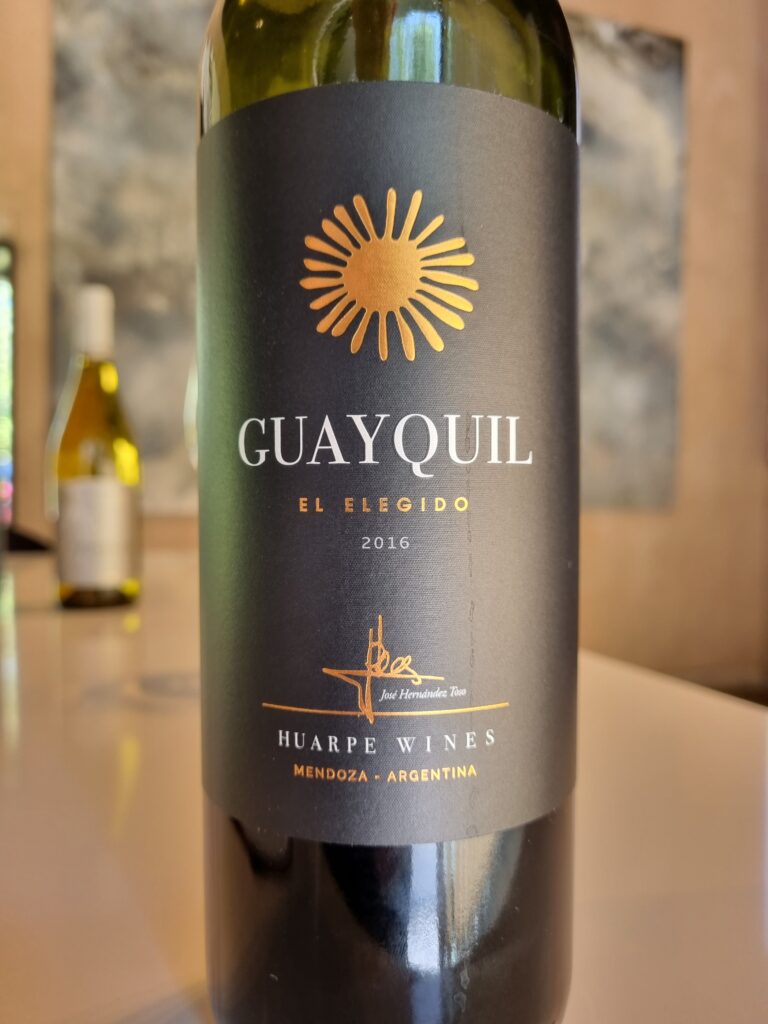
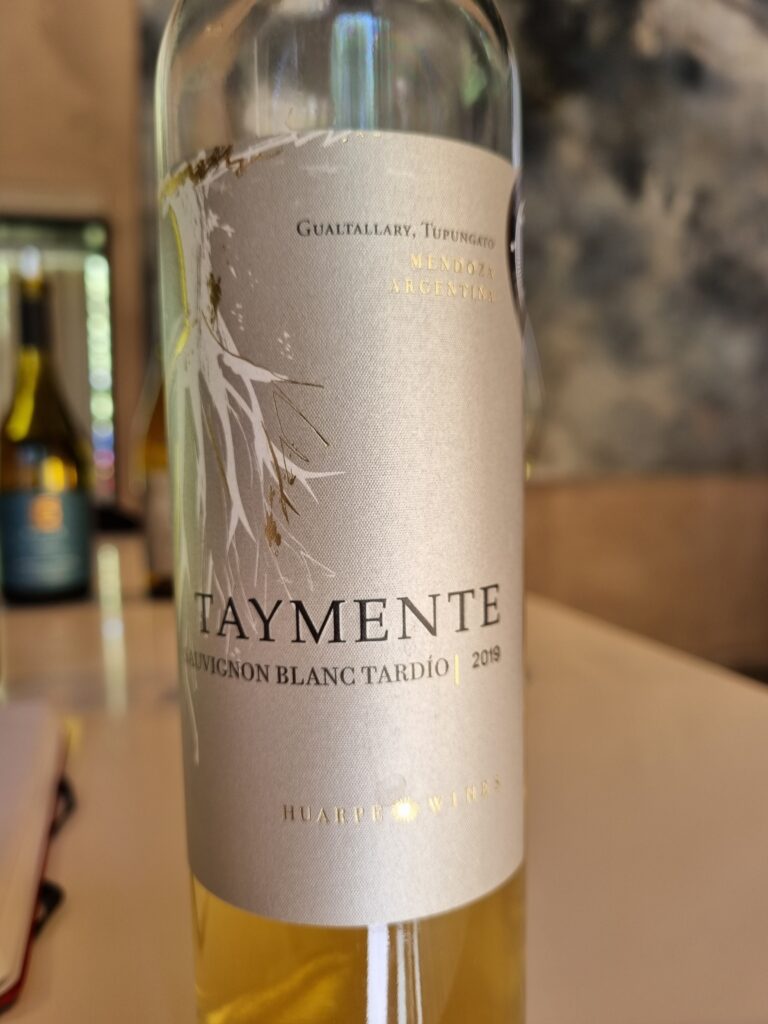
I tasted 6 Huarpe wines, starting with the inevitable Torrontes from the 2022 vintage (which didn’t leave me with a better image of this variety).
The others were:
2021 Riglos Gran Chardonnay, from Las Divas single vineyard in the Gualtallary district: more yellow than gold in color with a varietal, but herbaceous nose. The wine was unfortunately served too cold to taste it properly, so it seemed more neutral than it probably was. Too much oak came through.
2017 Huarpe Vista Flores Bonarda and Petit Verdot (also some Corbeau, a grape variety from Savoie): Good, medium-deep color with a floral, licorice, and blueberry nose. Soft, then tangy, then somewhat harsh on the palate with granulated tannin and high acidity. Needs to age. More interesting and off the beaten track than good.
2017 Riglos Gran Cabernet Franc, from Las Divas vineyard in the Gualtallary district: fine color with tertiary, chocolate, and Port nuances. A little green on the palate with white pepper nuances. Short oaky finish.
2016 Guayquil “El Elegido” (Malbec, Cabernet Sauvignon, , Petit Verdot, Tannat, and Bonarda): browning rim, looking older than its age. The nose was funky and slightly oxidized with cherry liqueur overtones. Lively, with marked acidity. Dry tannin on the finish, indeed, ultimately too dry, but still a good wine.
2019 Taymente late harvest Sauvignon Blanc: 6,000 bottles produced. Nose of white fruit with some mercapatan. Well-made, but more of a technological success than a delicious wine.
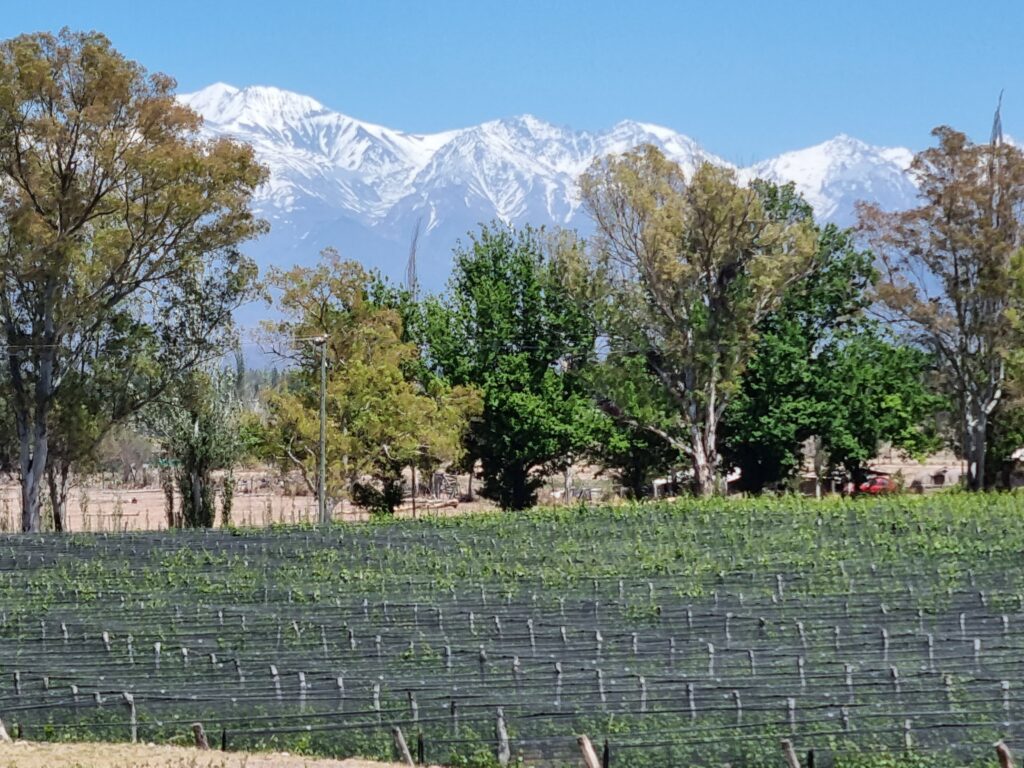
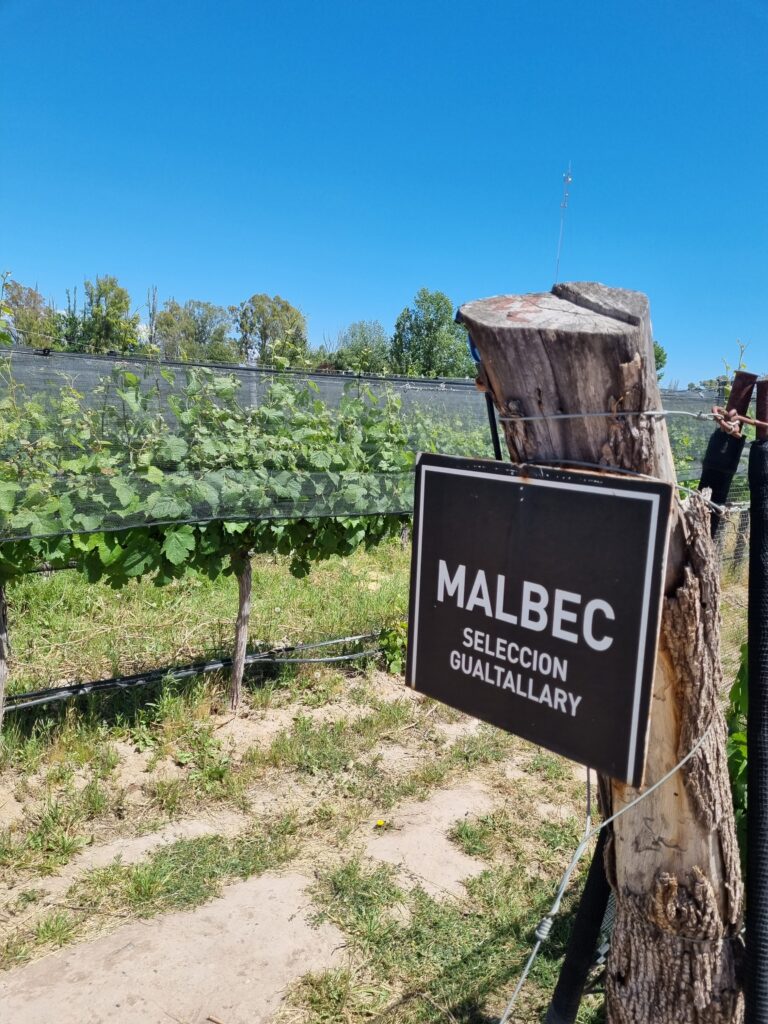
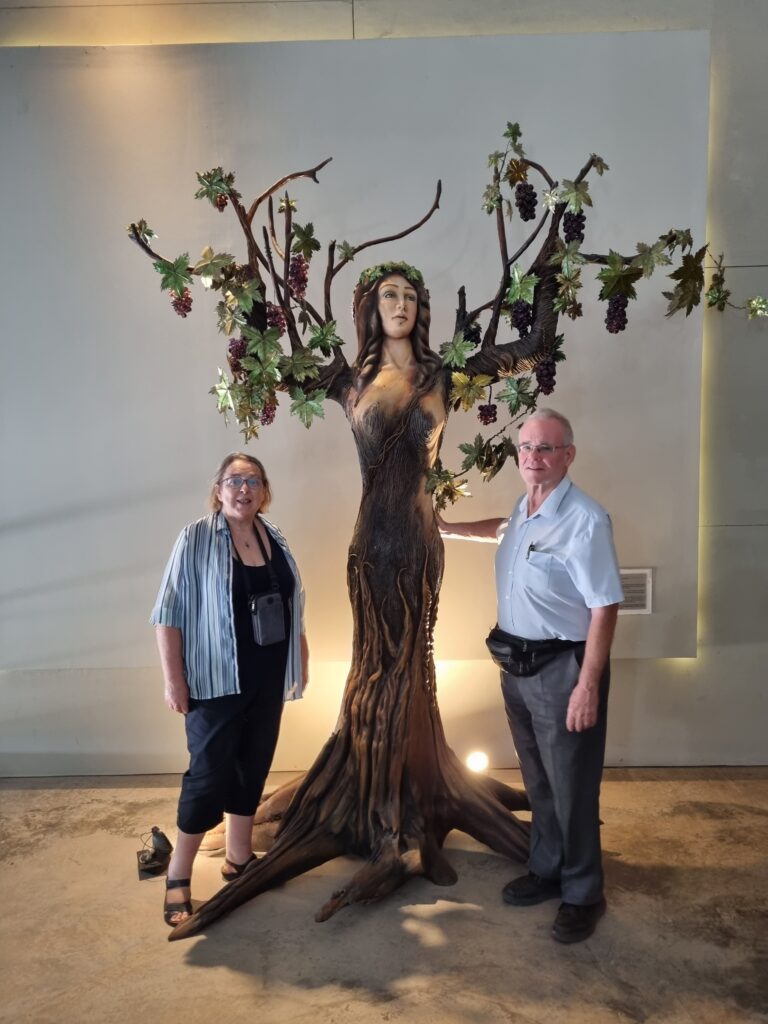
Budeguer: Located in Agrelo, this winery was founded in 2005 by Juan José Bueguer who made a fortune in sugar cane. The attractive modern winery, geared up for wine tourism and affording a great view of vines against the snowcapped Andes, now produces 1.2 million bottles a year. Their 105 hectares of vines are located in both Maipu and Agrelo.
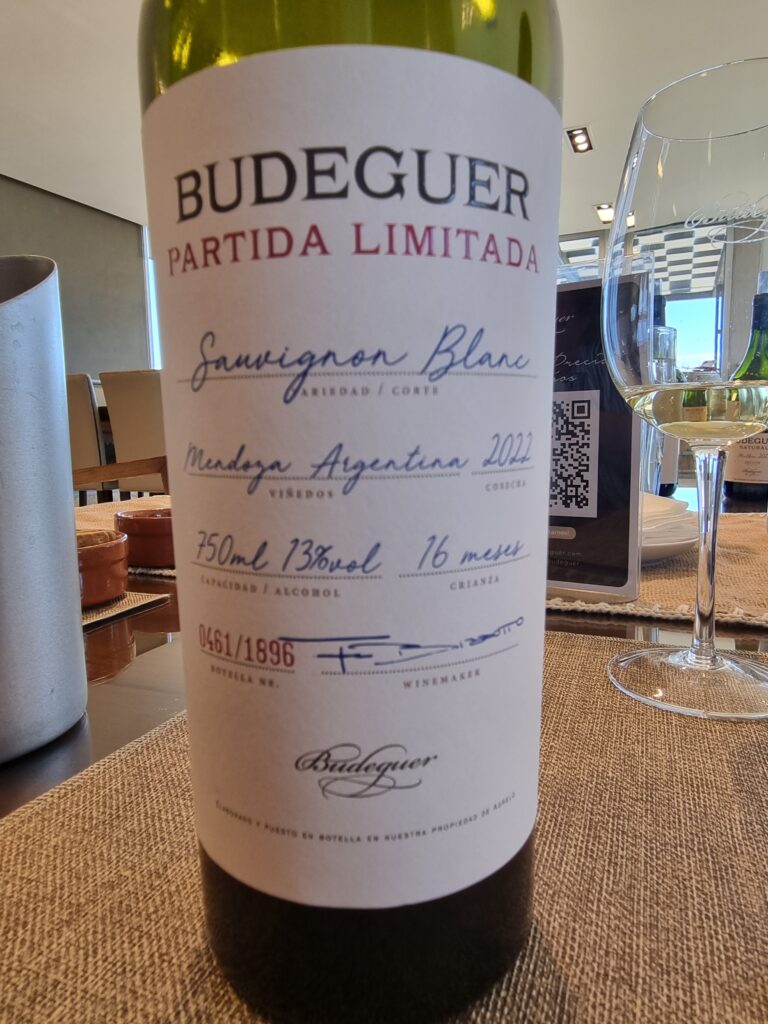
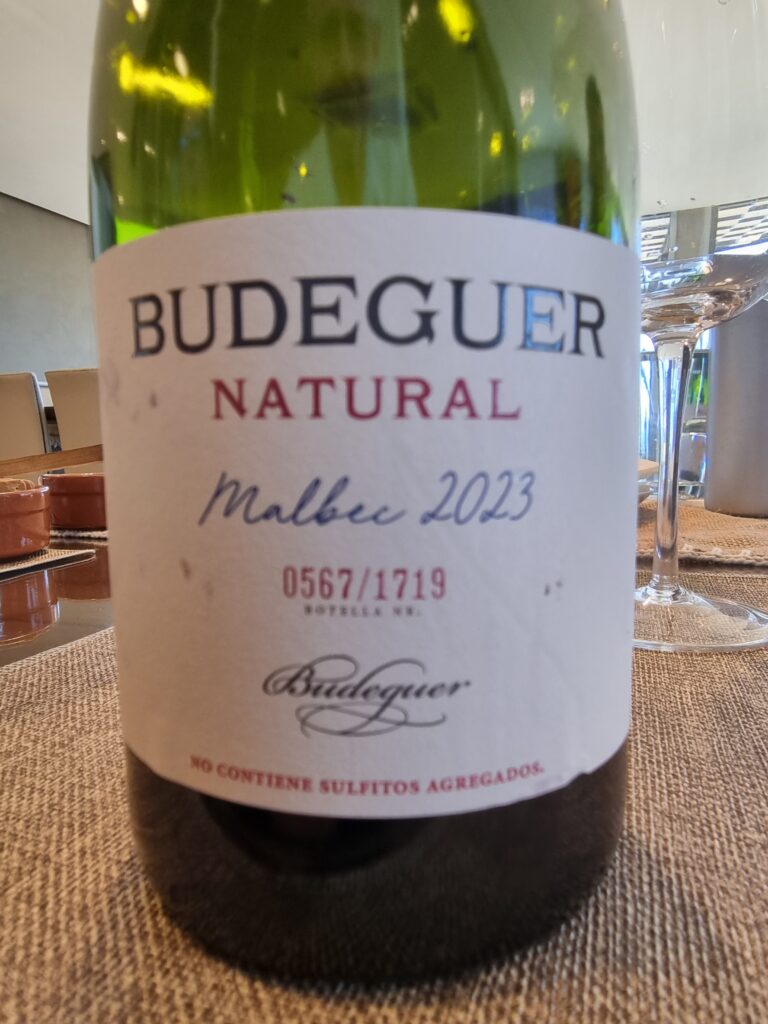
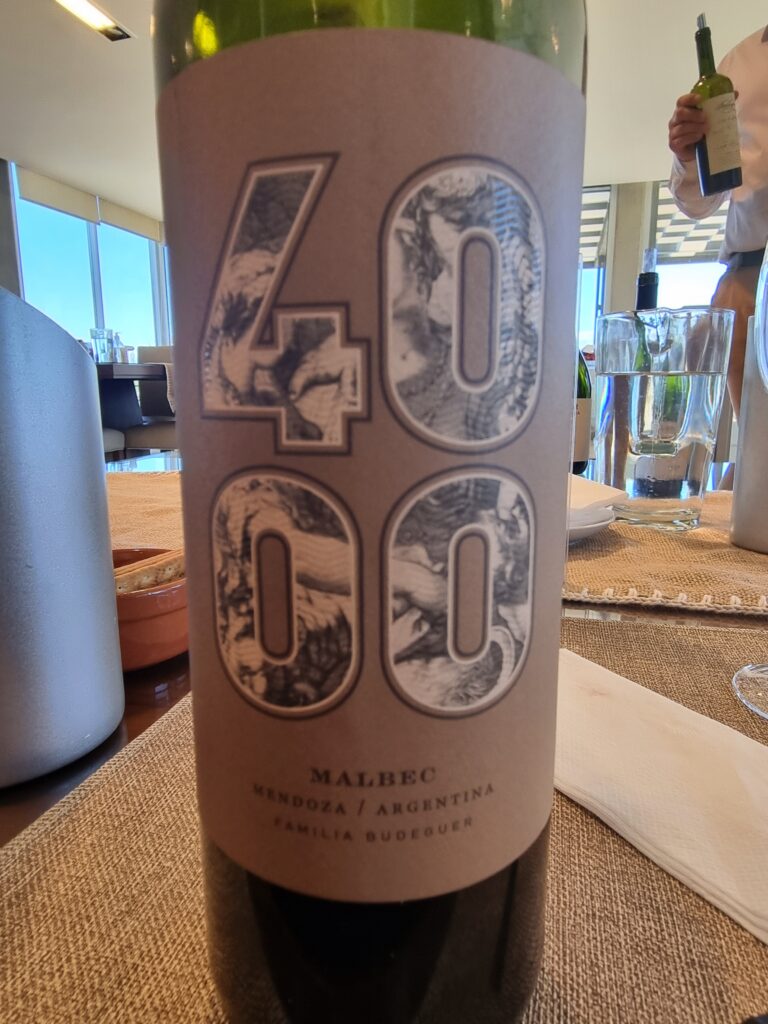
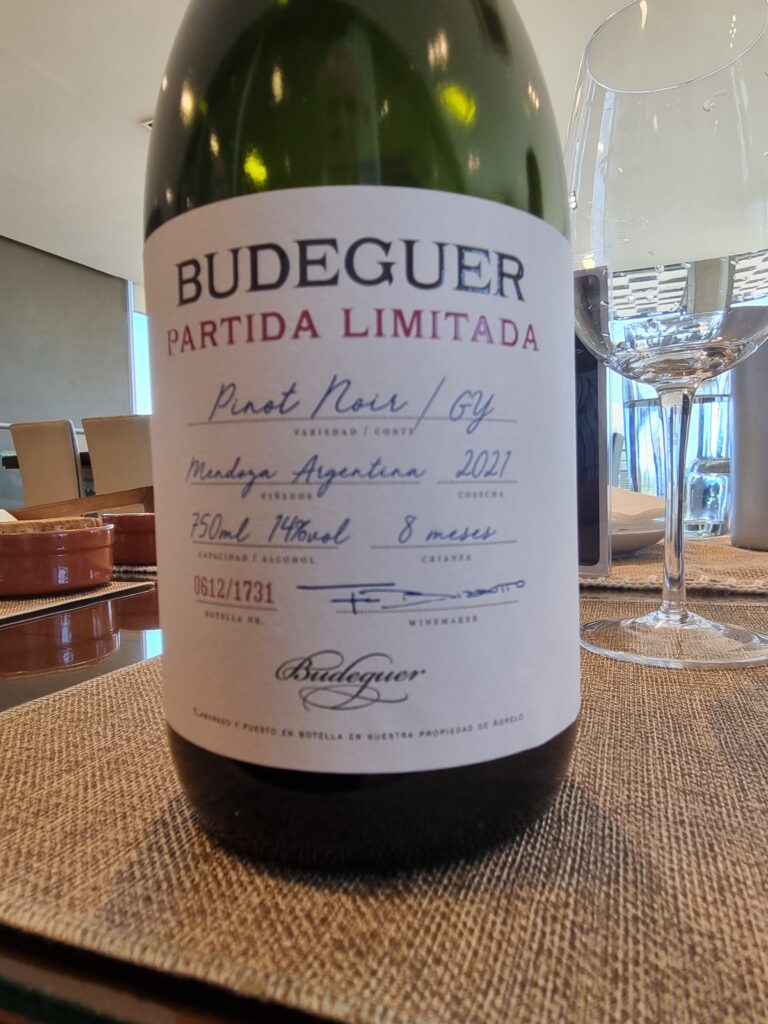
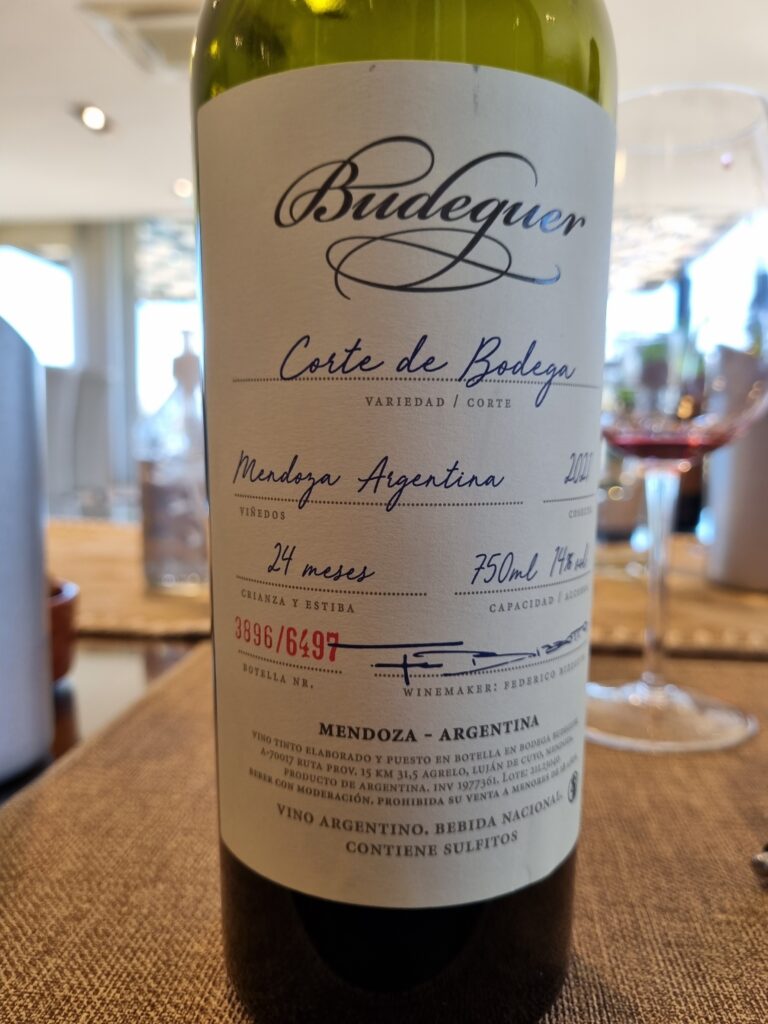
We were taken around by a young man who was nervous because this was his first tour in English, but he had nothing to worry about. We tasted six wines while admiring the beautiful landscape. The 2022 Sauvignon Blanc was understated and relatively short, but pure and mercifully not overoaked. The 2021 Pinot Noir looked surprisingly old. It featured a cherry-vanilla and slightly ferrous nose. The wine was unfortunately a bit hollow and sharp on the palate, with none of Pinot’s softness. The 2023 Malbec Natural had a lovely deep purplish color and an upfront candied fruit nose. It displayed the better aspects of so-called natural wine and was superior to most I have tasted. I especially appreciated the berry blossom aromatics. The 2001 4000 Mendoza Malbec weighs in at 14.2 % alc./vol. It had a lovely color and lots of oak, but somehow this was not really bothersome. The flavor was strong and penetrating with rather high acidity. It needs to age. The 2020 Black Blend had a soft bouquet and a taste that reminded me of a big satisfying Côtes du Rhône with a pleasing berry fruit finish. My favorite wine of the tasting was the 2021 Corte de Bodega that had a nose of lovely dark fruit and a sensual melts-in-your-mouth texture. A very successful blend of Malbec, Petit Verdot, Merlot, and the two Cabernets.
We did not taste Budeguer’s top of the line: Patrimonio. This is the most expensive wine we saw in Argentina, weighing in at 78,400 pesos, or 96 US dollars.
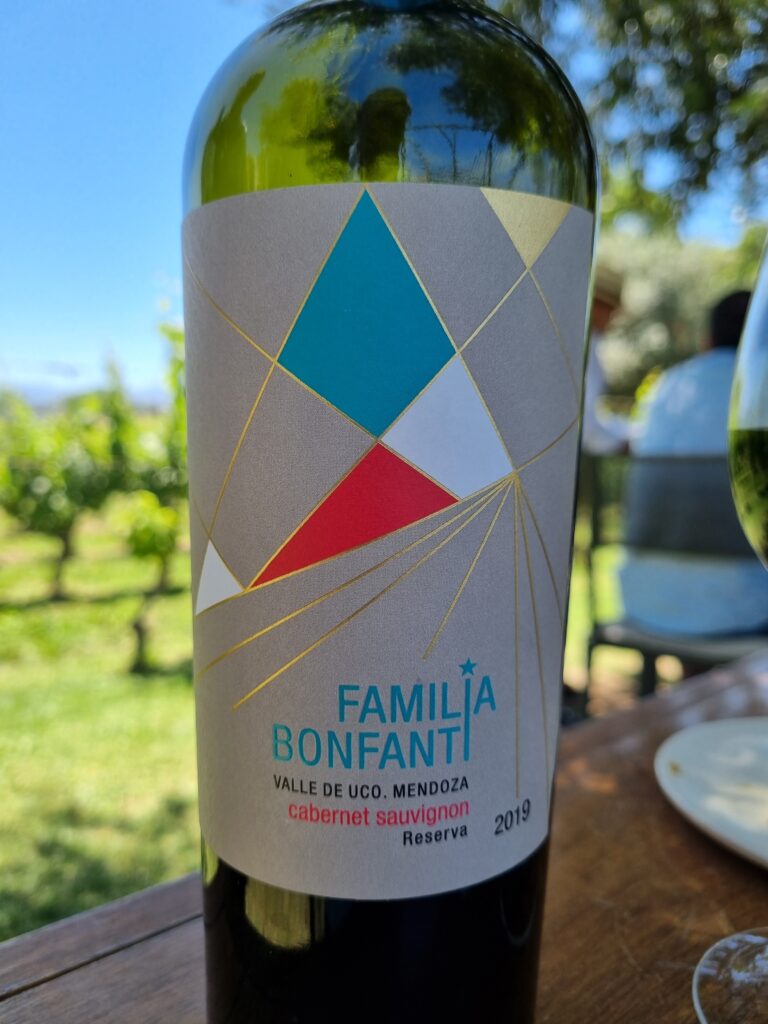
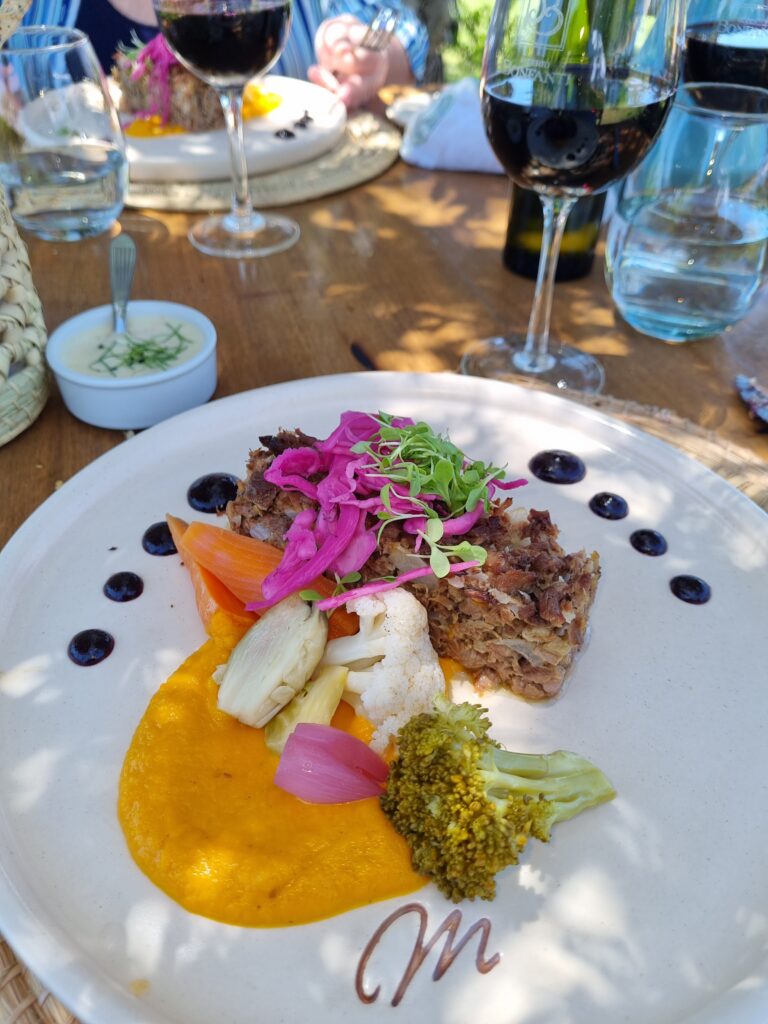
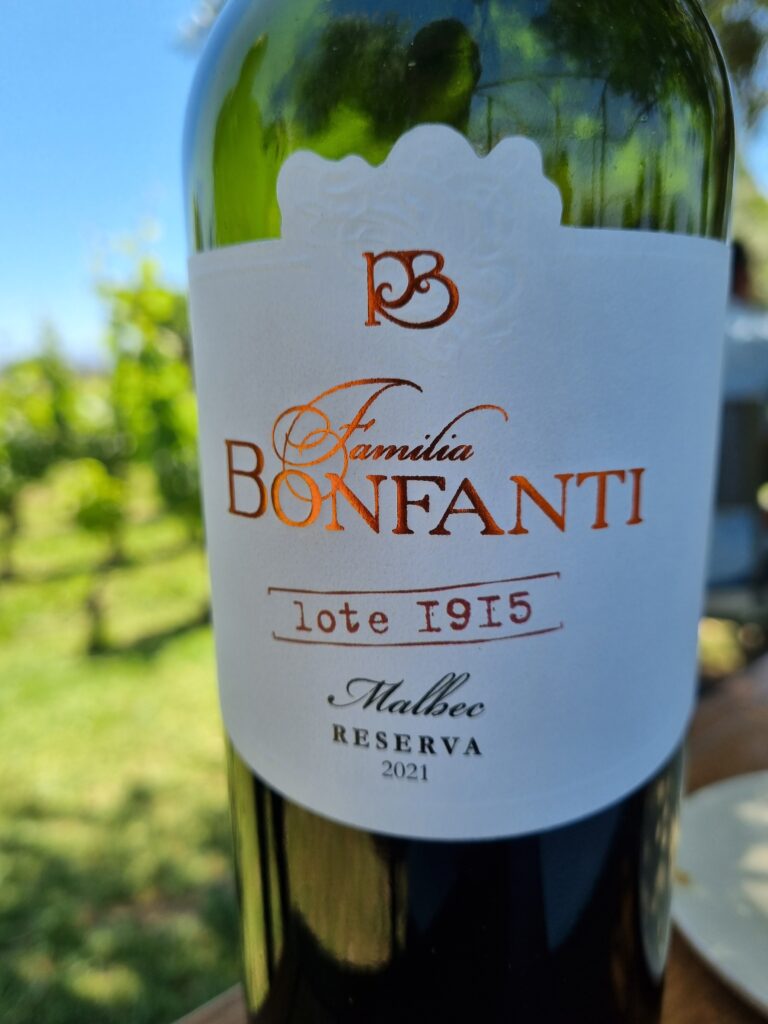
We went on to enjoy lunch at a winery we did not in fact visit: Bonfanti in Lujan de Cuyo. This small boutique winery has just 8 hectares of vines in Perdiel and Marrancas (Maipu), as well as olive trees. We ate outside in an idyllic setting almost literally between vine rows under a clear blue sky, and the food was seriously good. A wonderful memory. We enjoyed the straight Malbec, the 2021 Lote 1915 (year of the winery’s founding) Reserve Malbec, and the 2019 Uco Valley Cabernet Sauvignon. Like most Argentinian wines we sampled, these showed very well young and made a fine accompaniment to the cuisine.
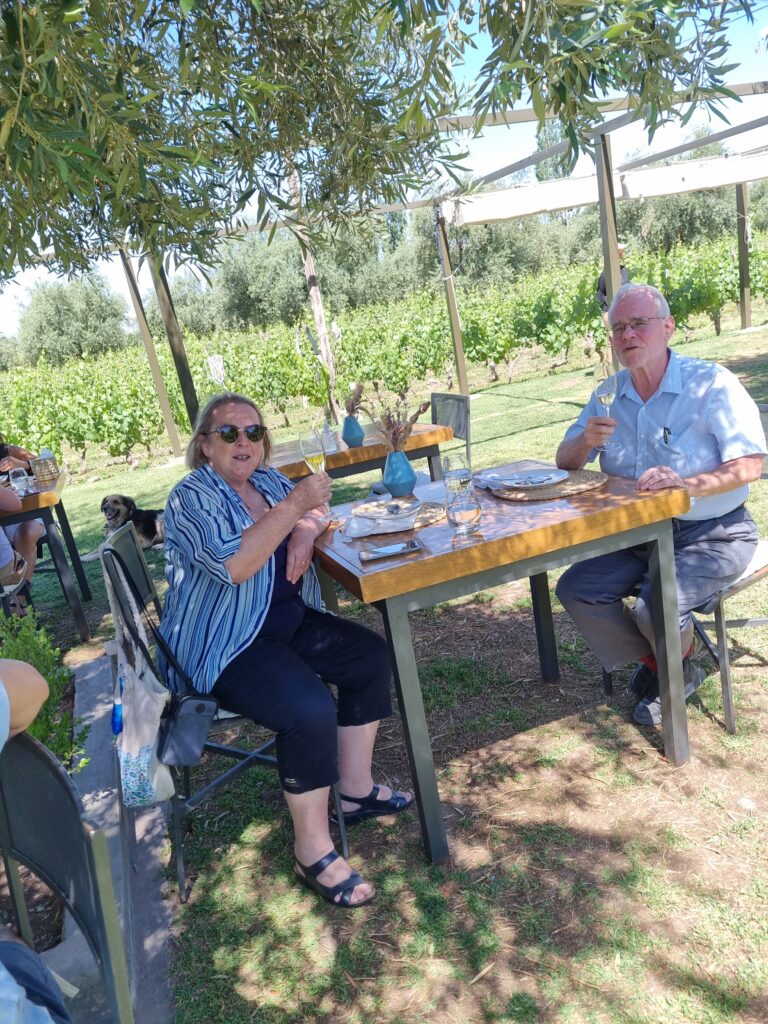
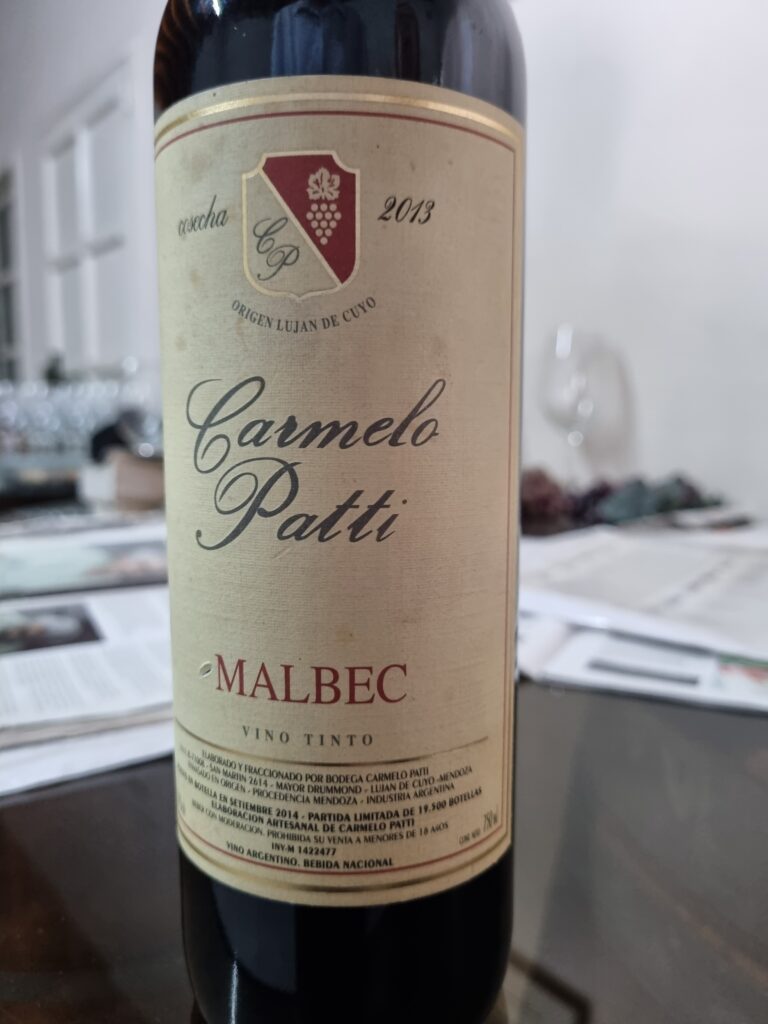
Our final visit was to Carmelo Patti, a very old-fashioned winery, a one-man show run by the eponymous owner who emigrated from Sicily as a child. Production is small (25-30,000 bottles a year), and Carmelo has been at it for over forty years. The scale and atmosphere are very reminiscent of a Burgundian producer. Carmelo holds many of his wines back a few years until he feels that they are ready to drink. We tasted two young wines and two old ones. The 2019 Cabernet Franc had an appealing chocolatey aroma and was somewhat acidic on the palate, but needs to be appraised down the line. The 2017 Gran Assemblage looked older than its age and featured a nose of old Bordeaux. Once again, there was marked acidity, but this was, even so, a very worthwhile wine to discover. The 2013 Cabernet Sauvignon looked decidedly old with an accompanying tertiary bouquet and was perhaps more interesting than together on the palate. A Malbec from the same year was unquestionably past its best with oxidative notes. Carmelo is a salt-of-the-earth vigneron and his wines need to be taken in a certain spirit. He is emblematic of a longstanding tradition.
There, this is one of my longest posts. Can I come up with an insightful conclusion? That would be pretty pretentious of me seeing as I only scratched the surface of Argentinian wine in one week. I will, however, say that the overall quality was really rather good. I see the wines as fruity, affordable, and enjoyable young. They represent good value for money. There is definitely a buzz there and some very dedicated winemakers aiming to make it on the international market. Wine tourism is developing apace, largely fuelled, when we were there, by Brazilians. The climate in Mendoza, thanks to the altitude, and despite the semi-desertlike topography, is conducive to wines of medium alcohol (14 %, much less 15% wines were the exception) and we are far removed from bruising New World monsters.
And what of Malbec? First of all, the relation between Cahors and Argentinian Malbec seems rather tenuous. It’s not just the terroir either. The clones in Argentina are very different. Putting forward Malbec to promote the wines of Argentina is a double-edged strategy because, on the one hand, it gives the country a unique identity but, on the other hand, it overshadows the excellent wines made from other varieties. This makes me think of Sauvignon Blanc in New Zealand… Like California three decades ago, Argentina is on the up-and-up and I have come away convinced that they will be a more important player on the world scene in years to come.

